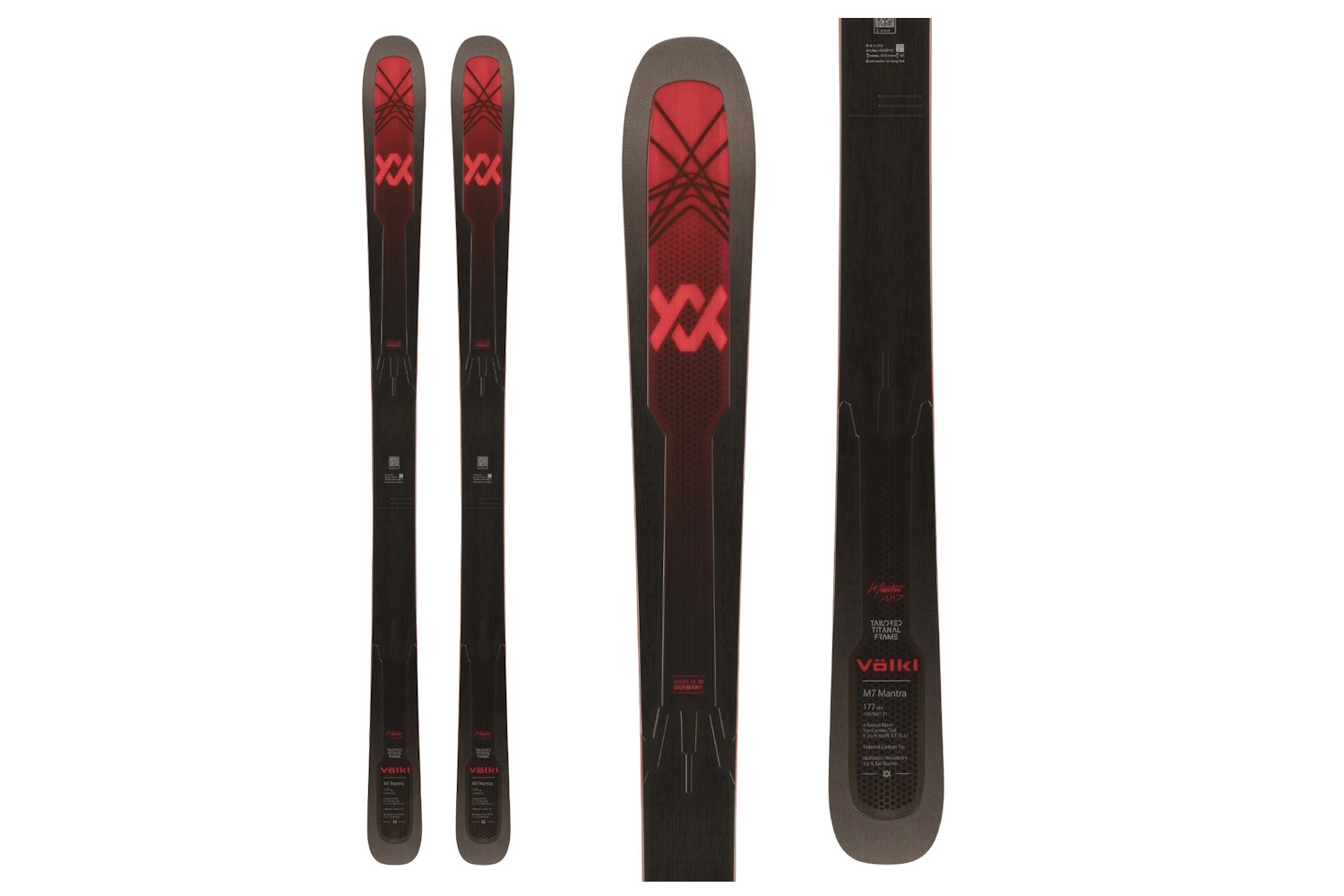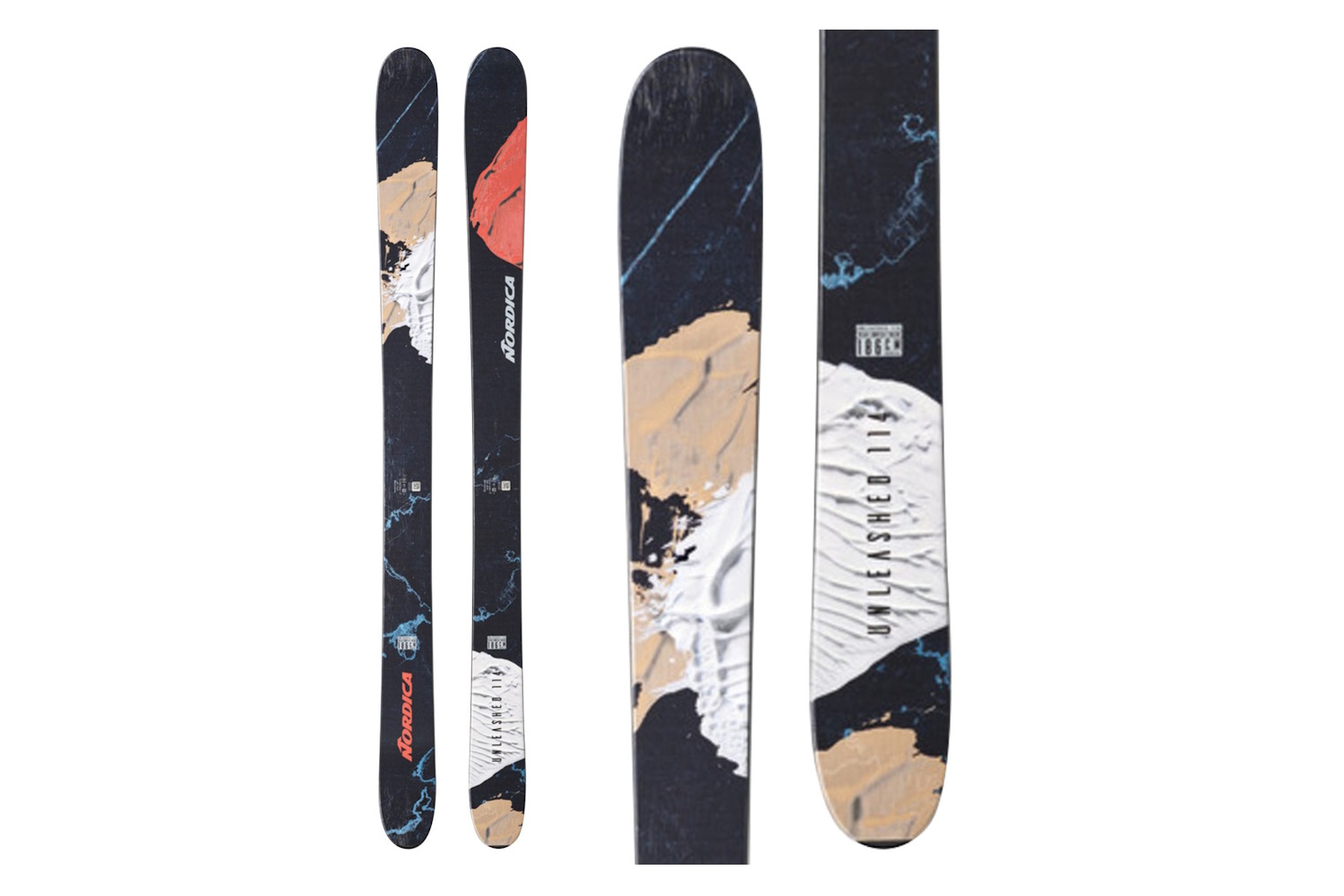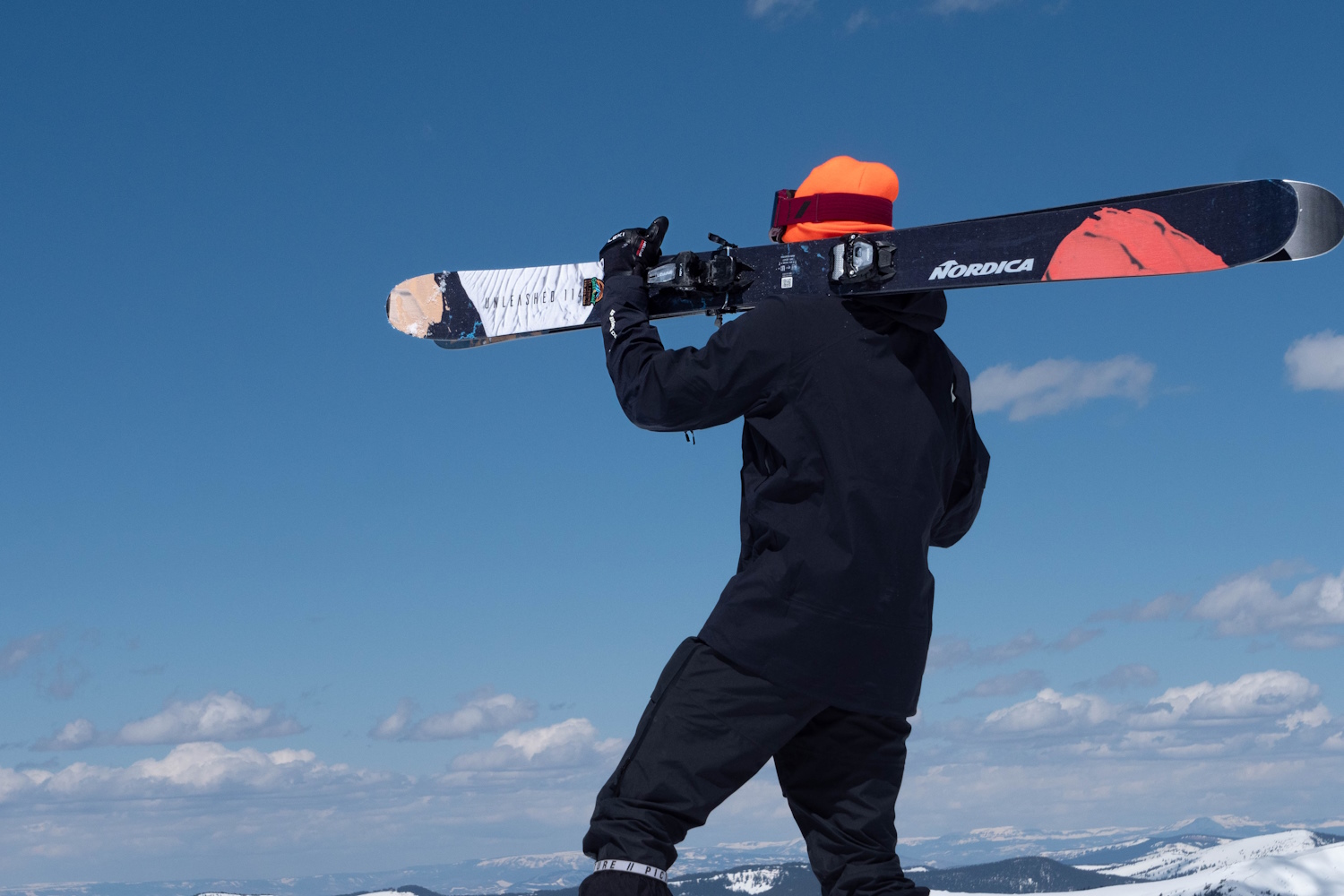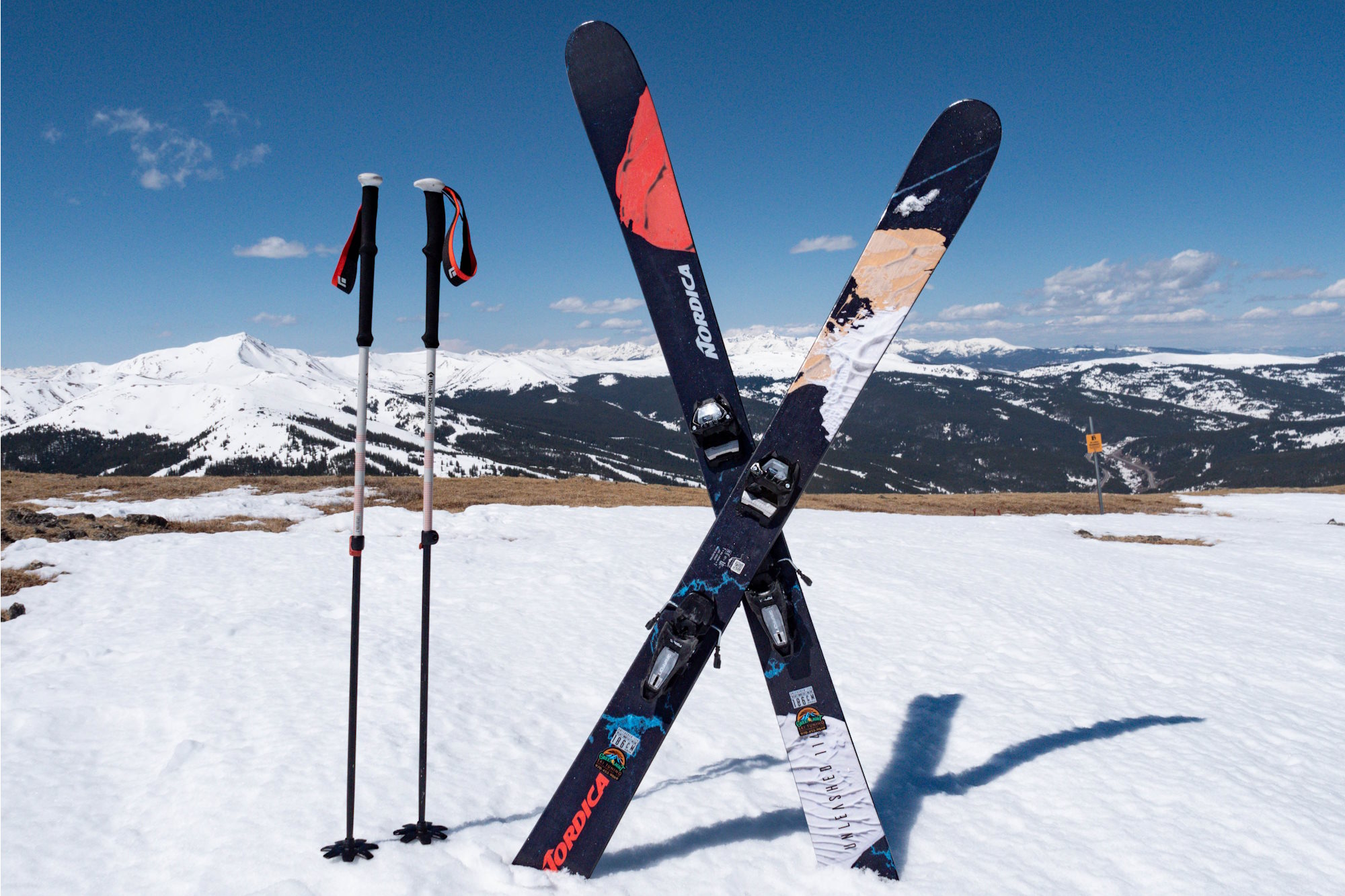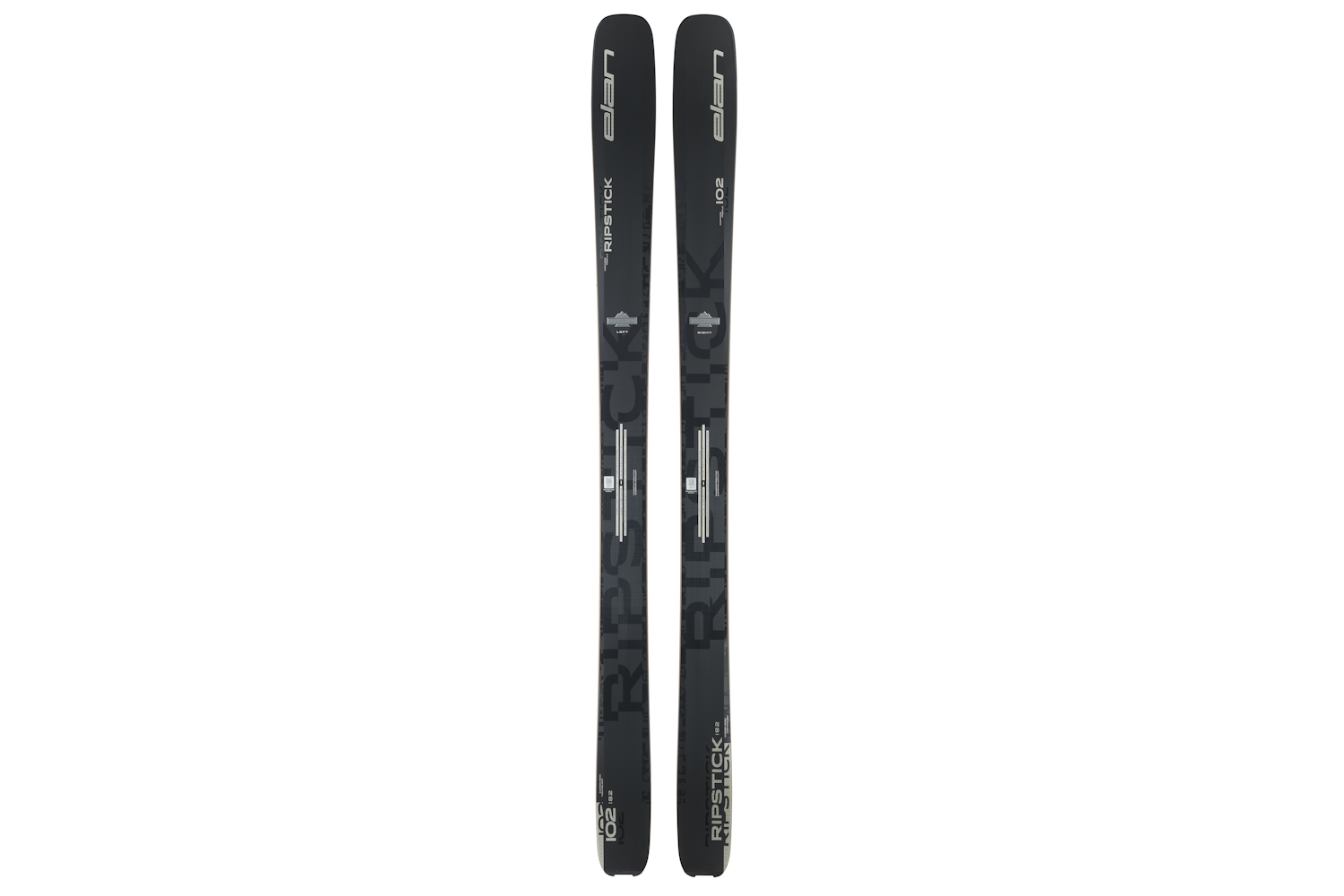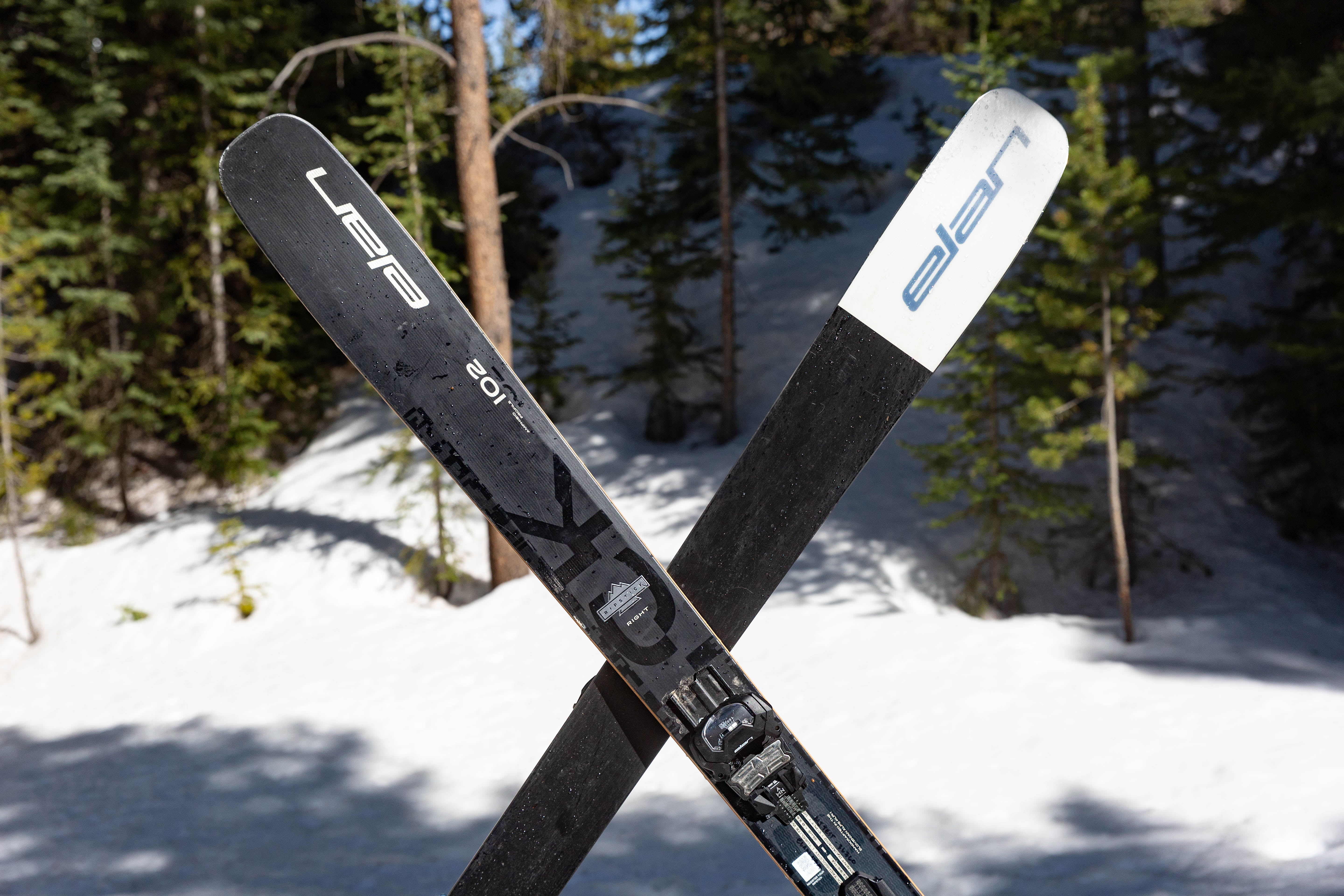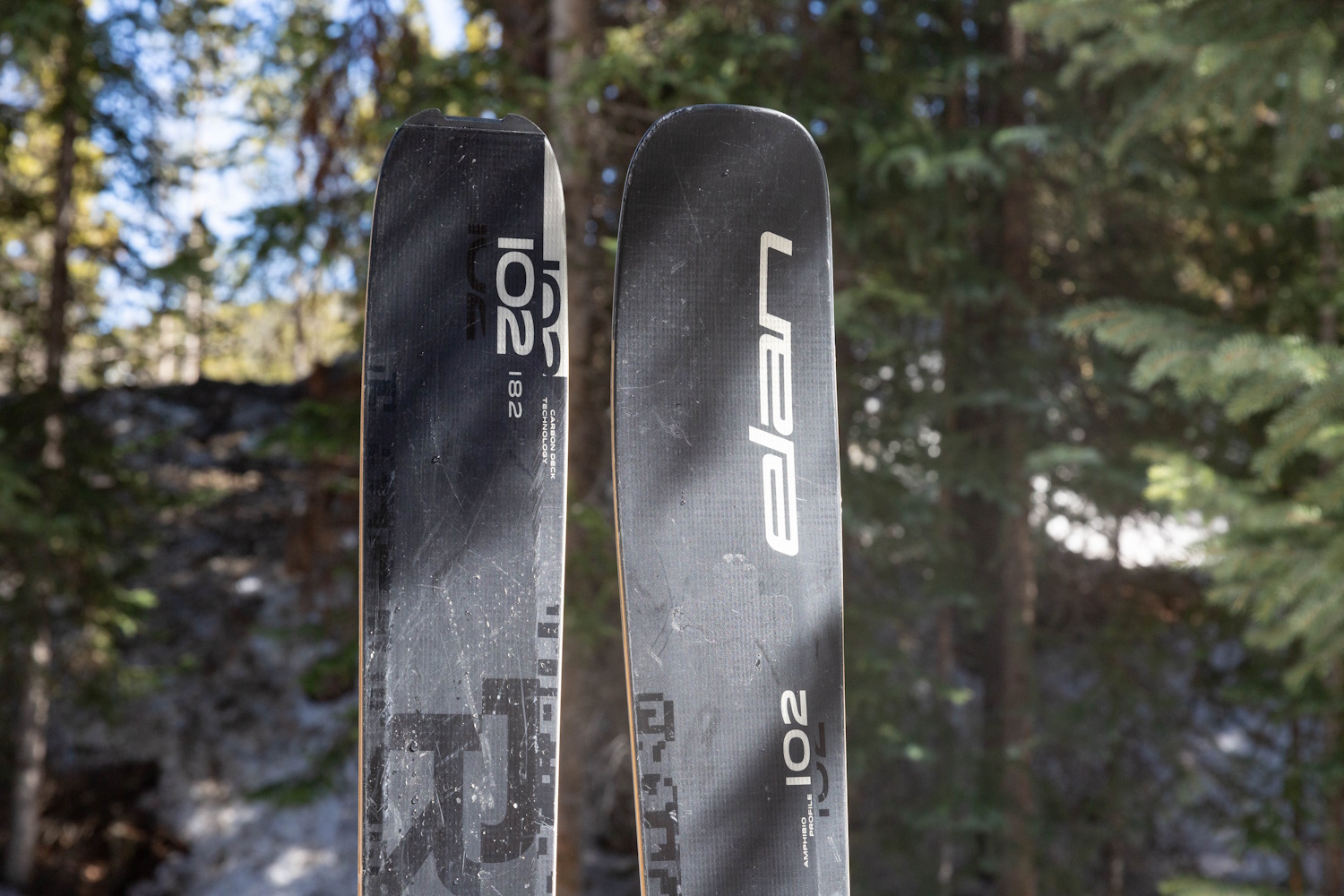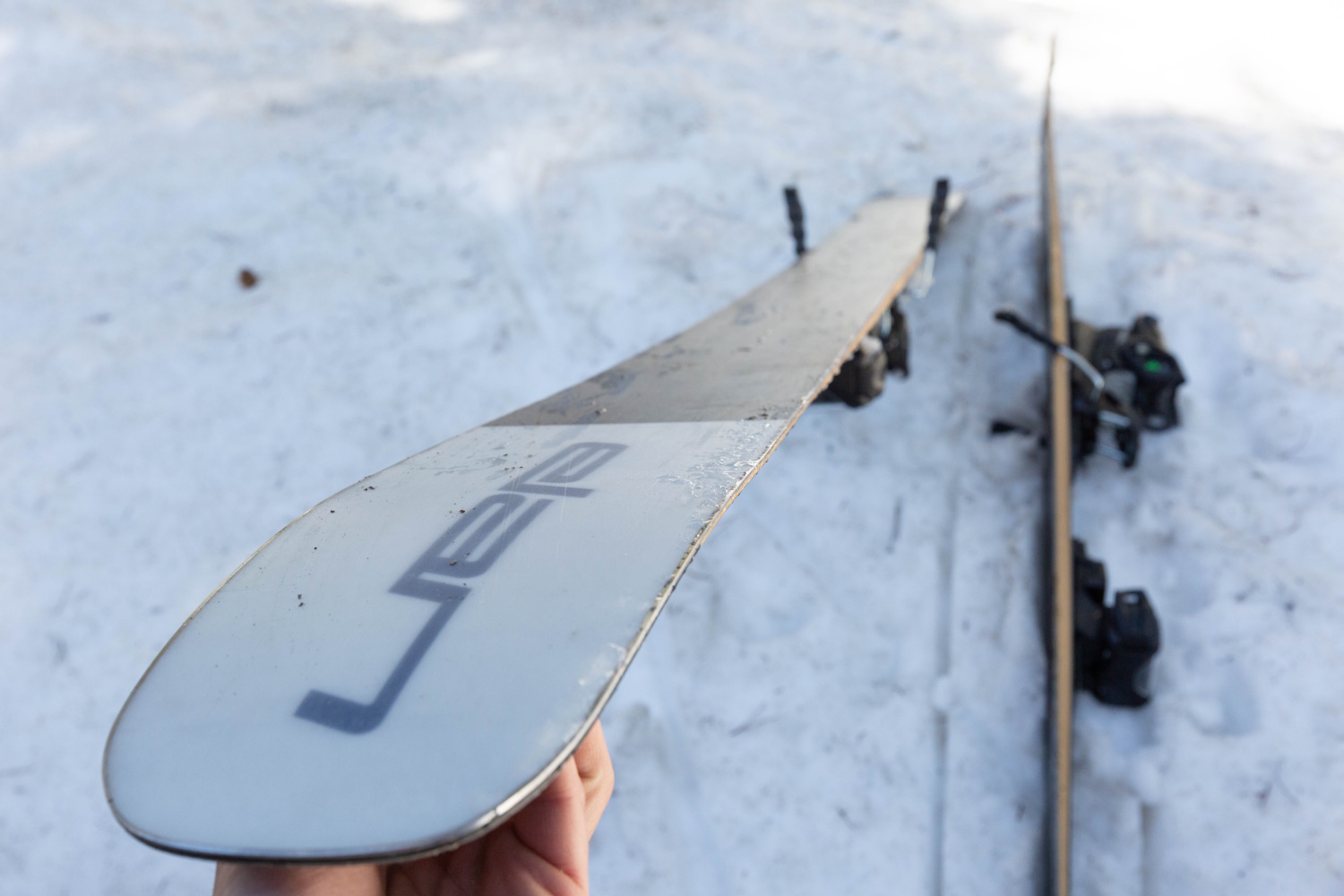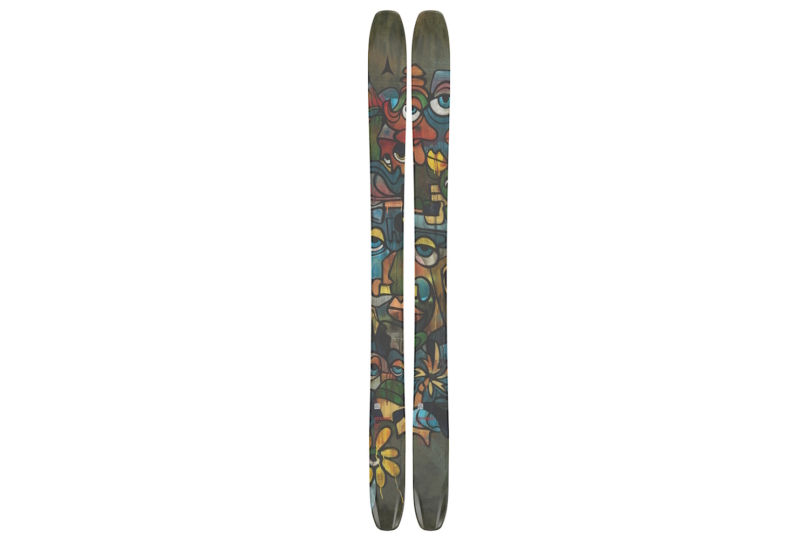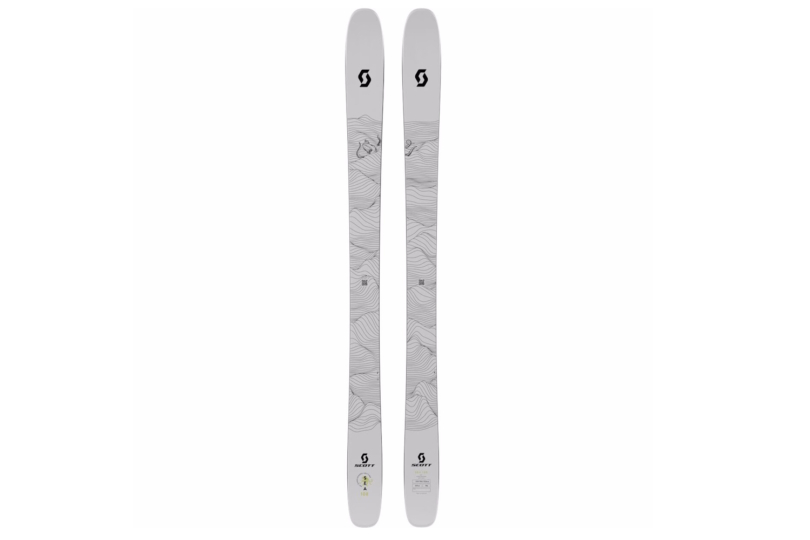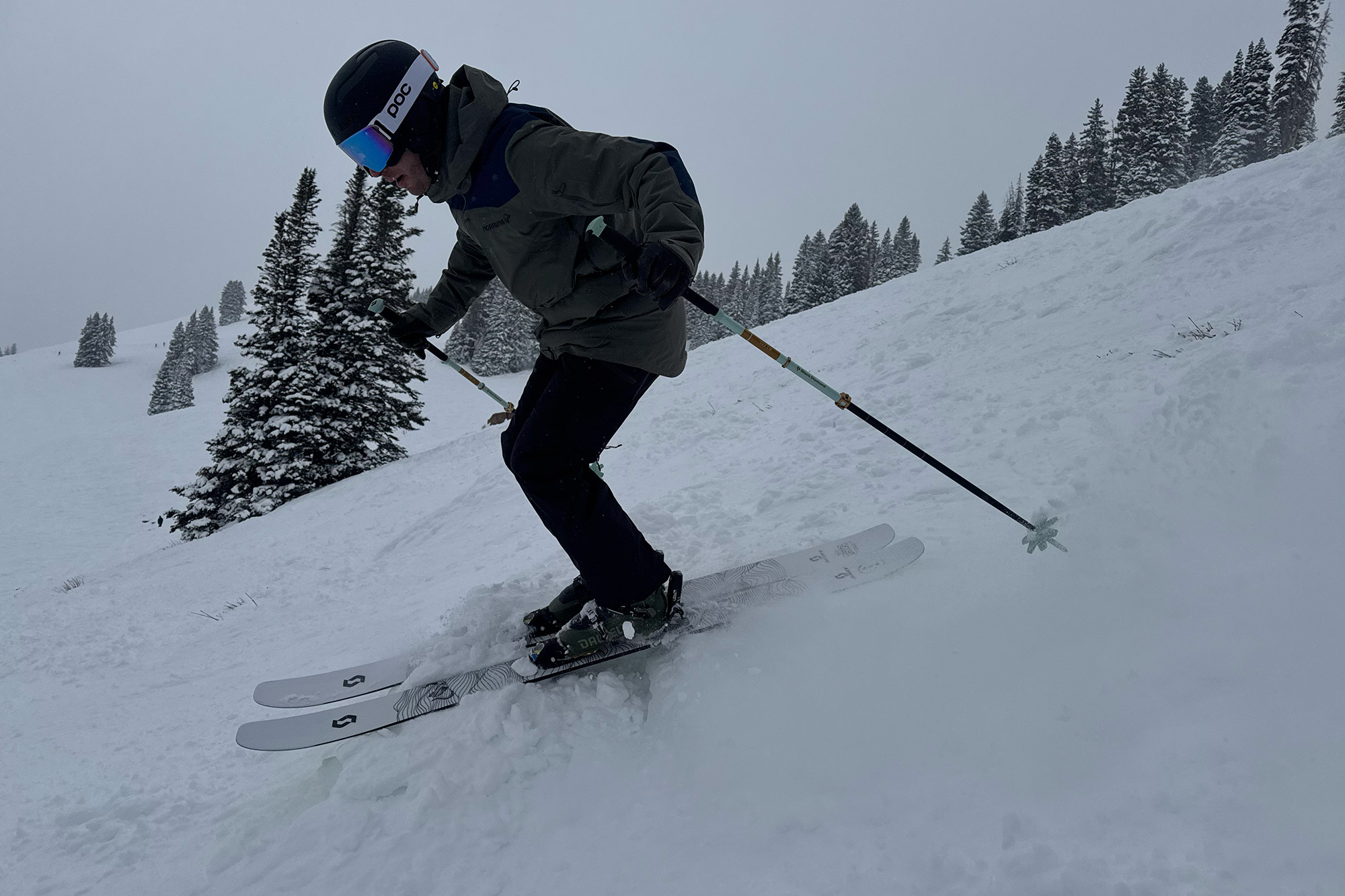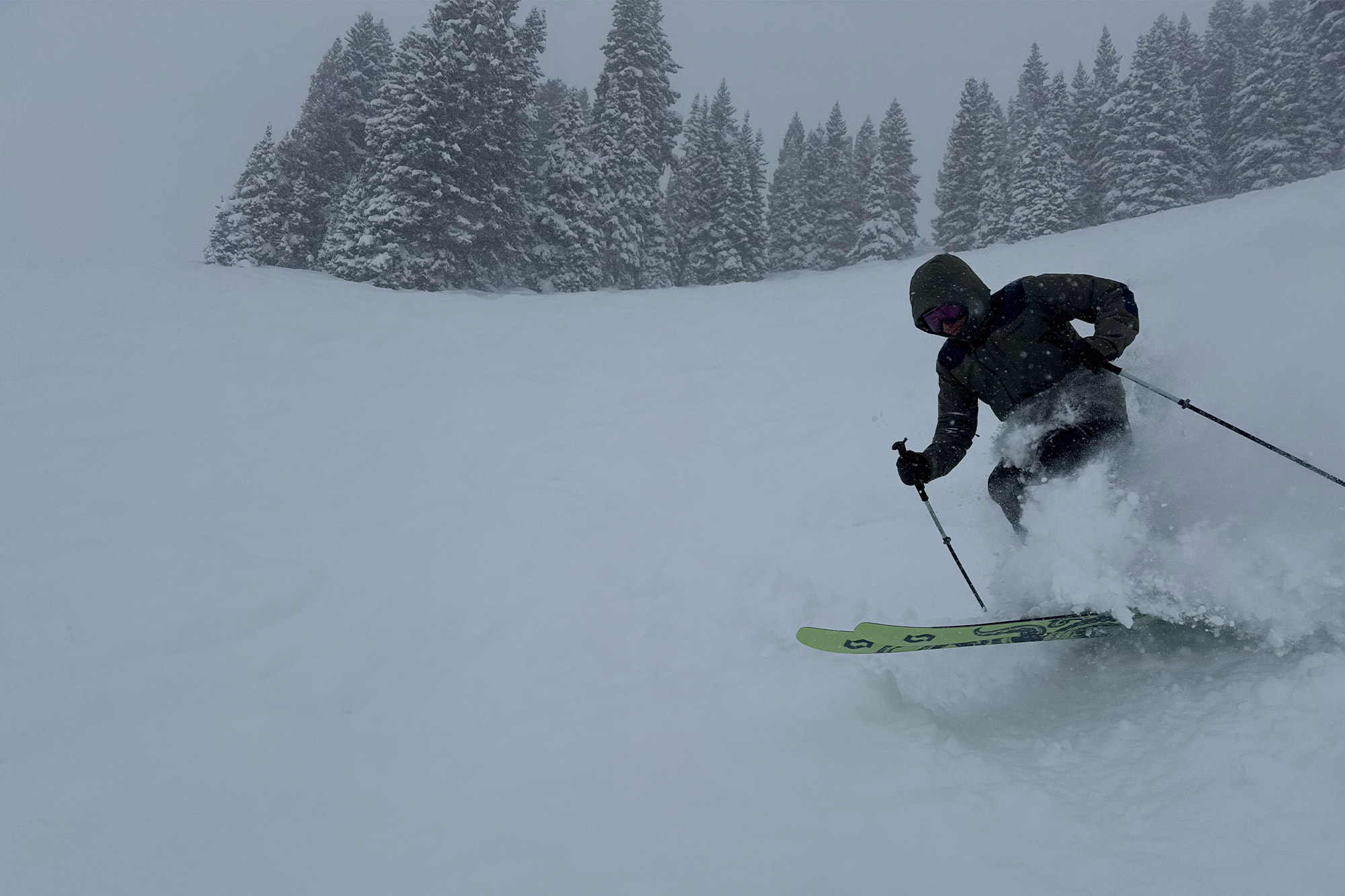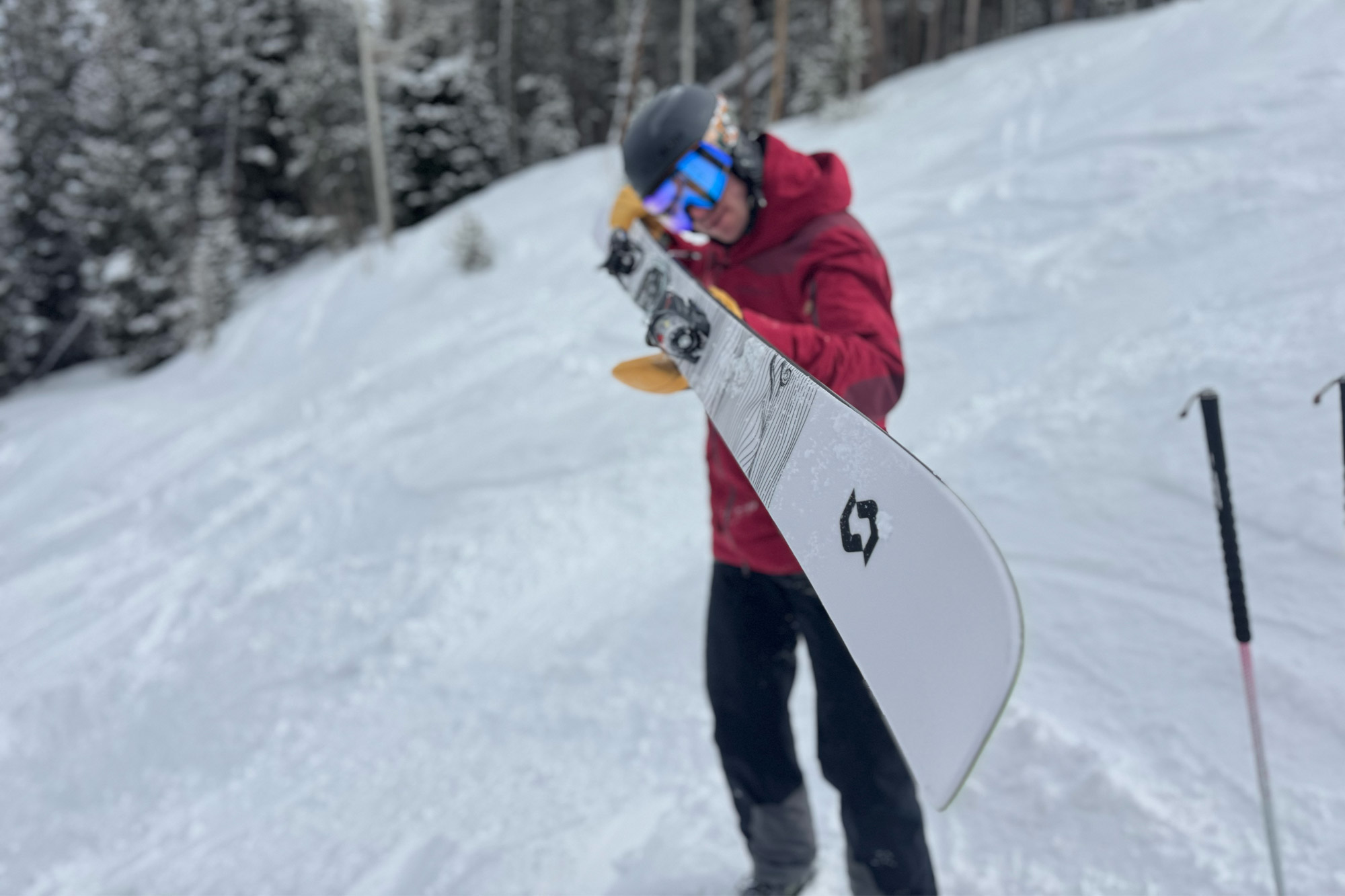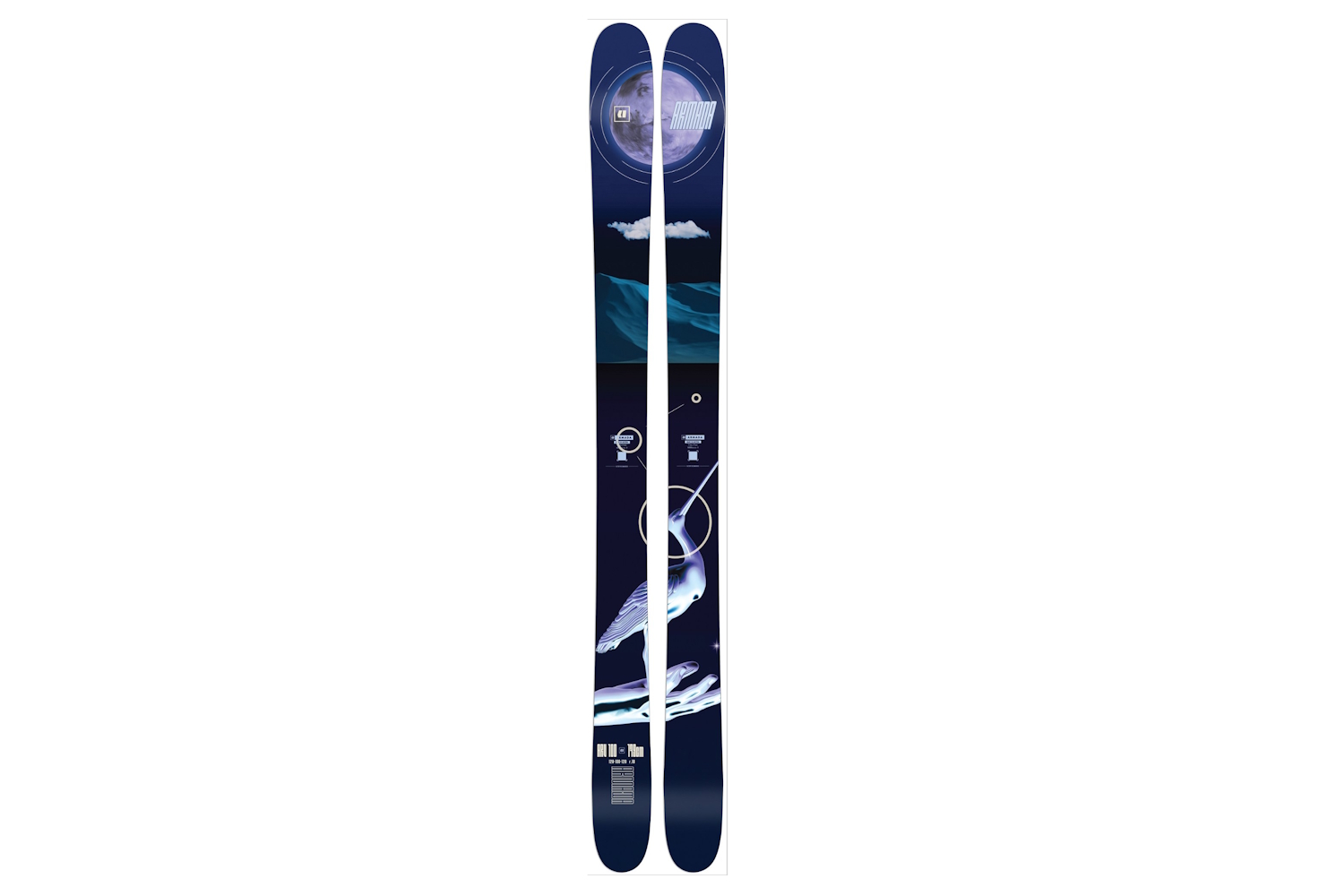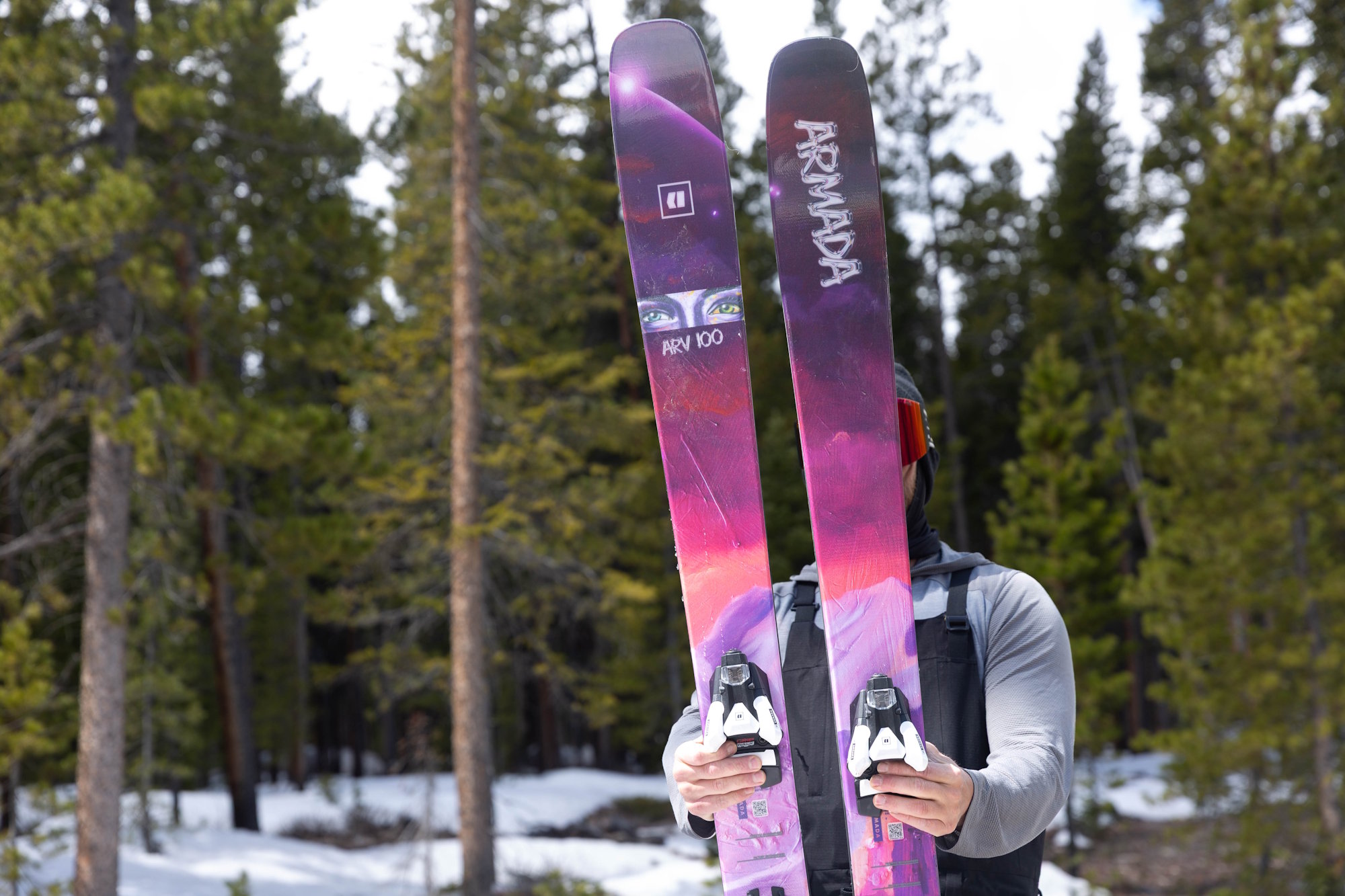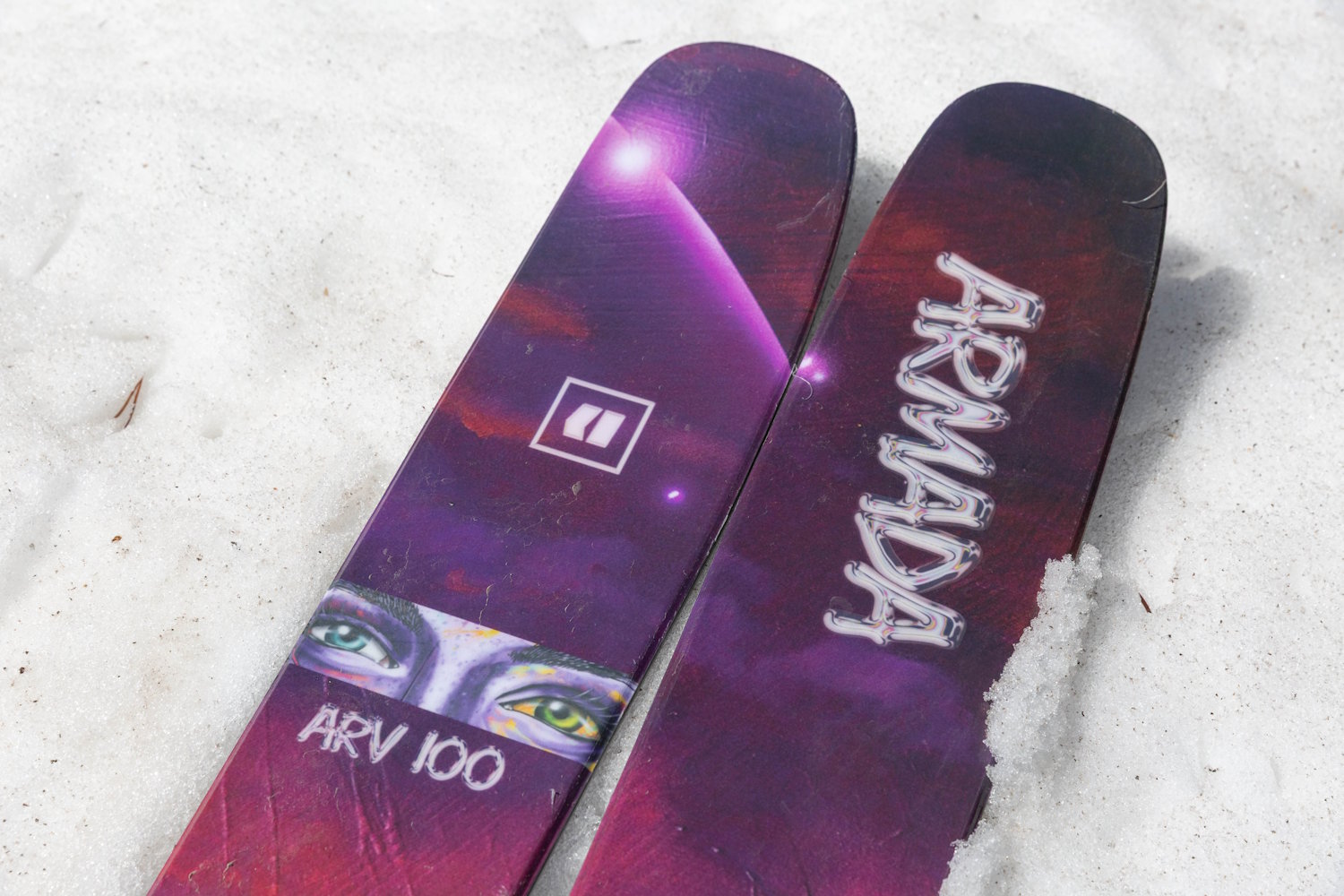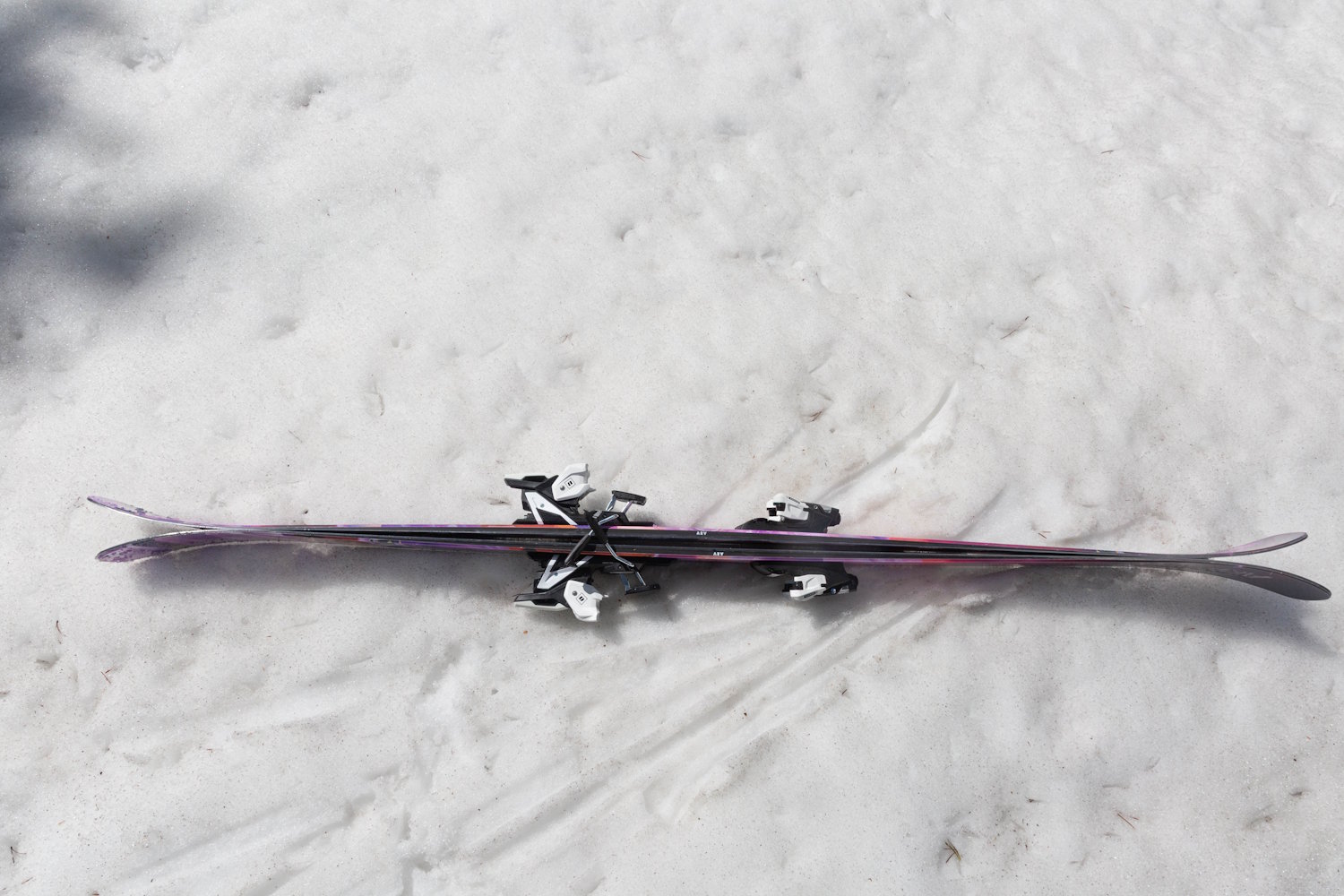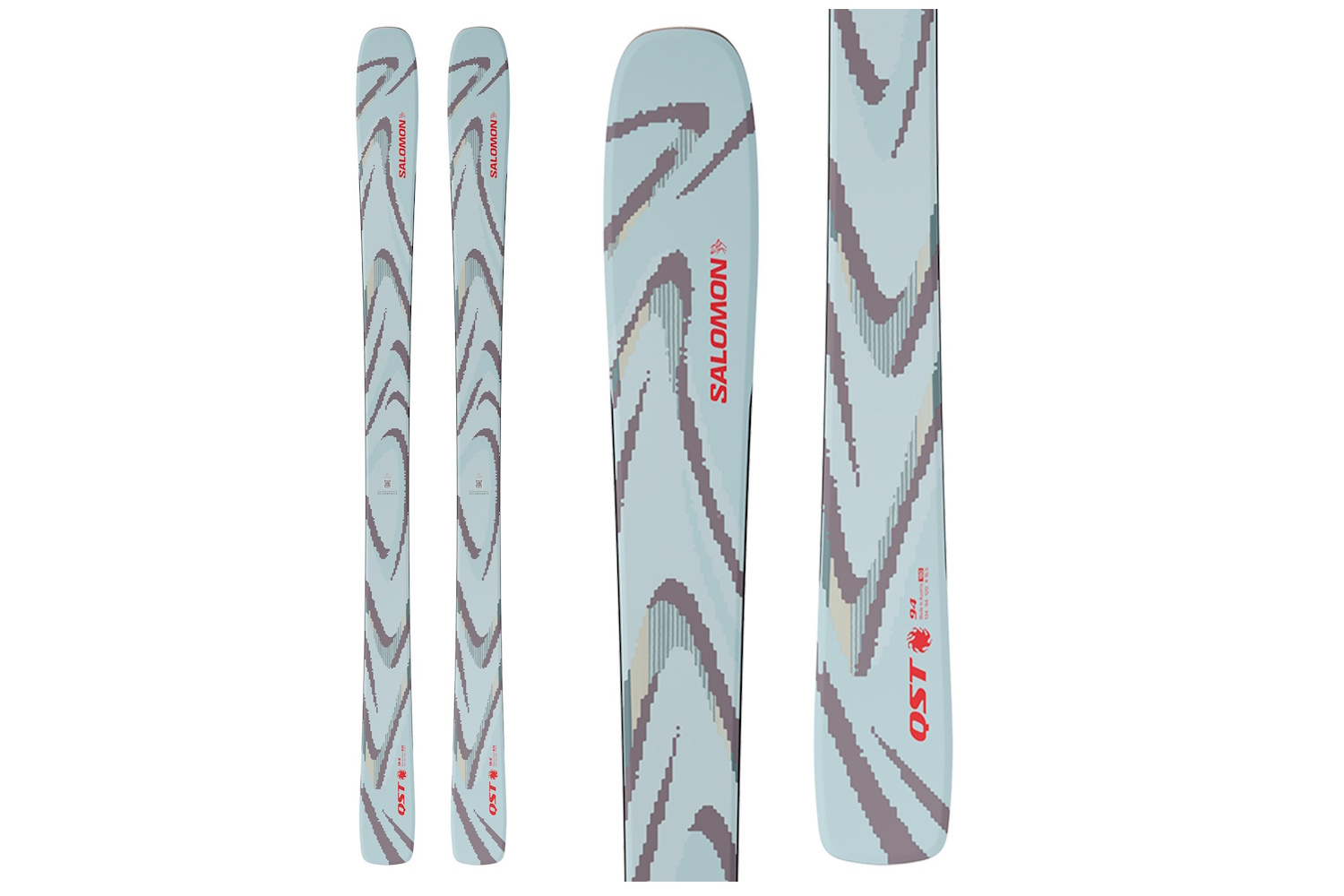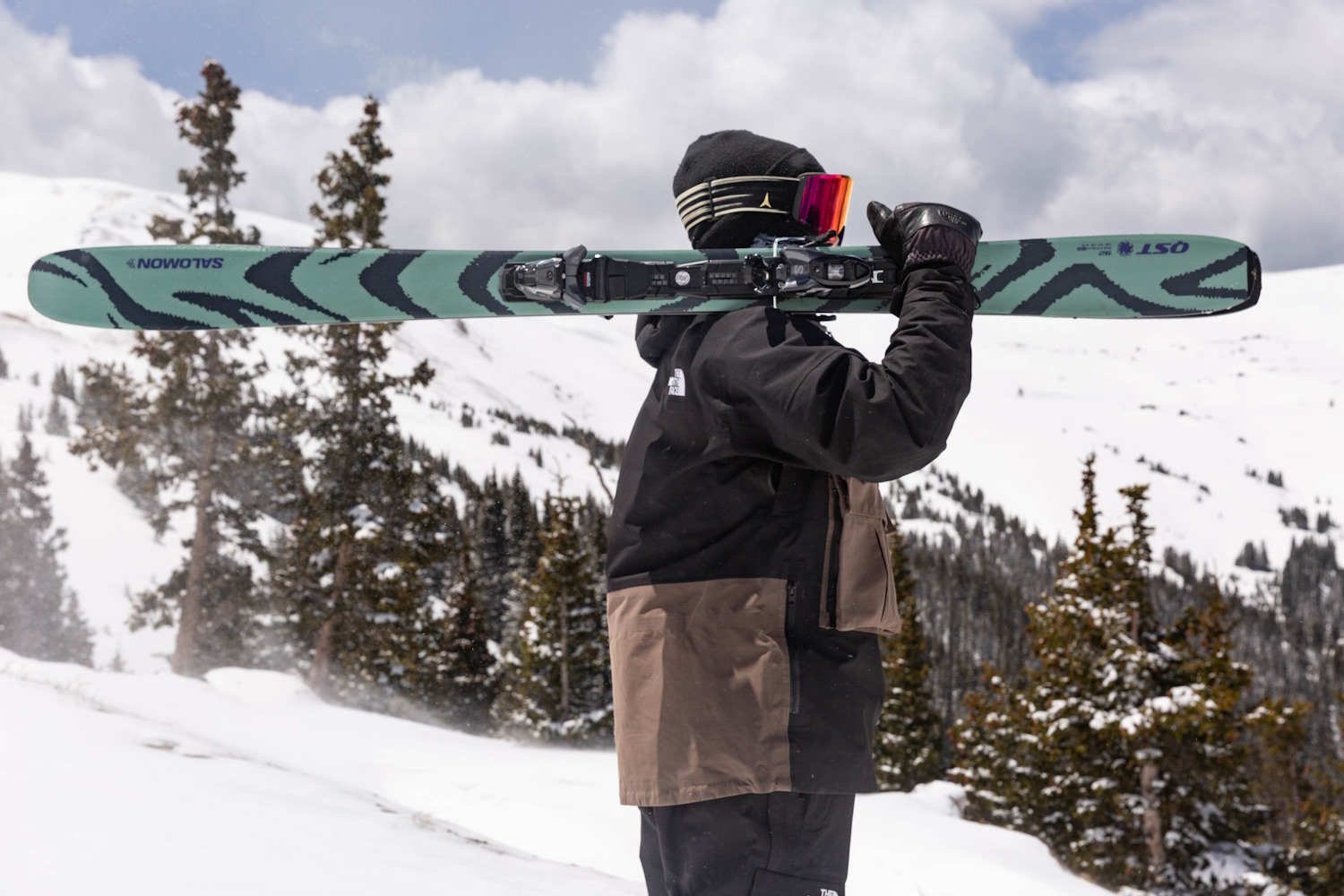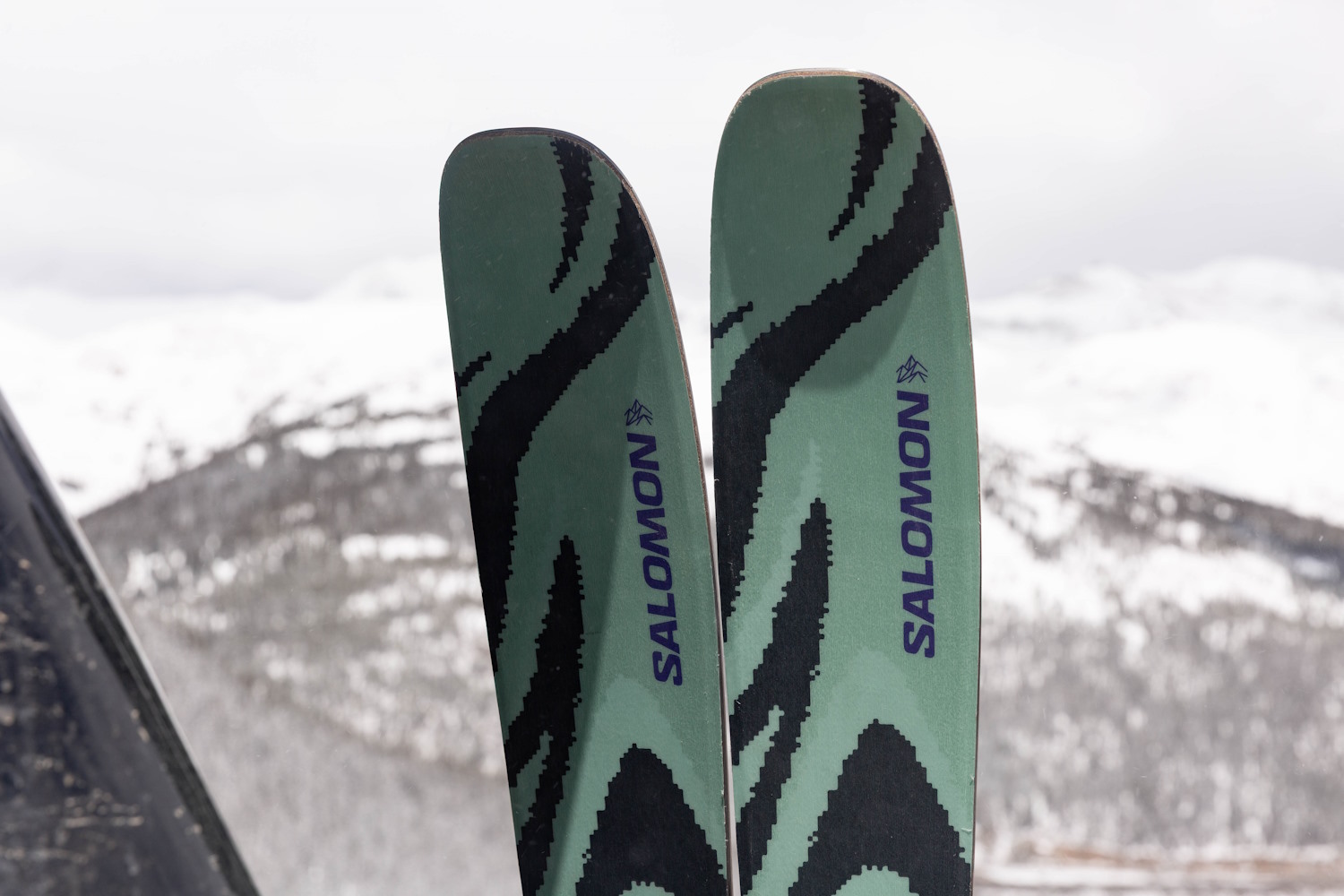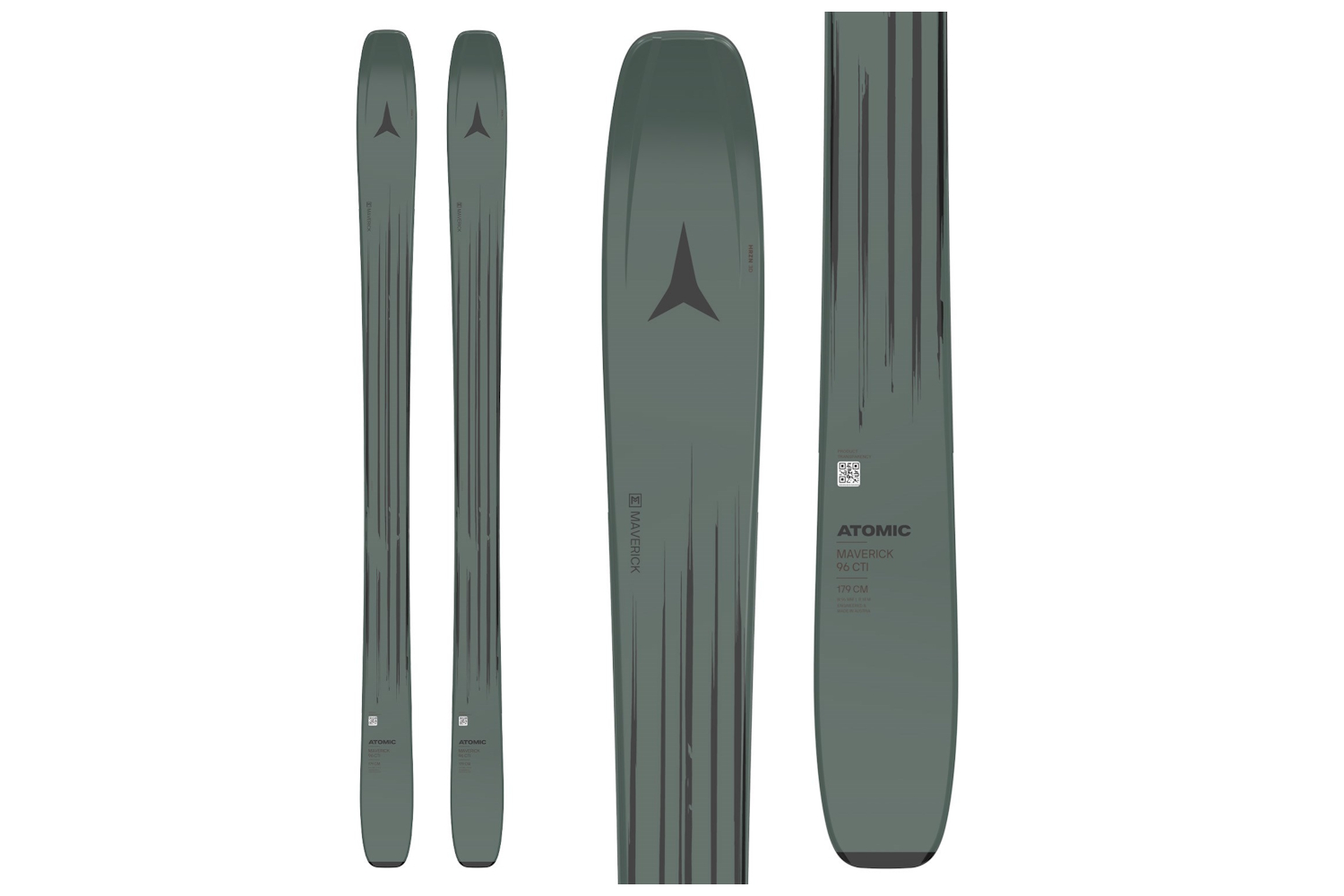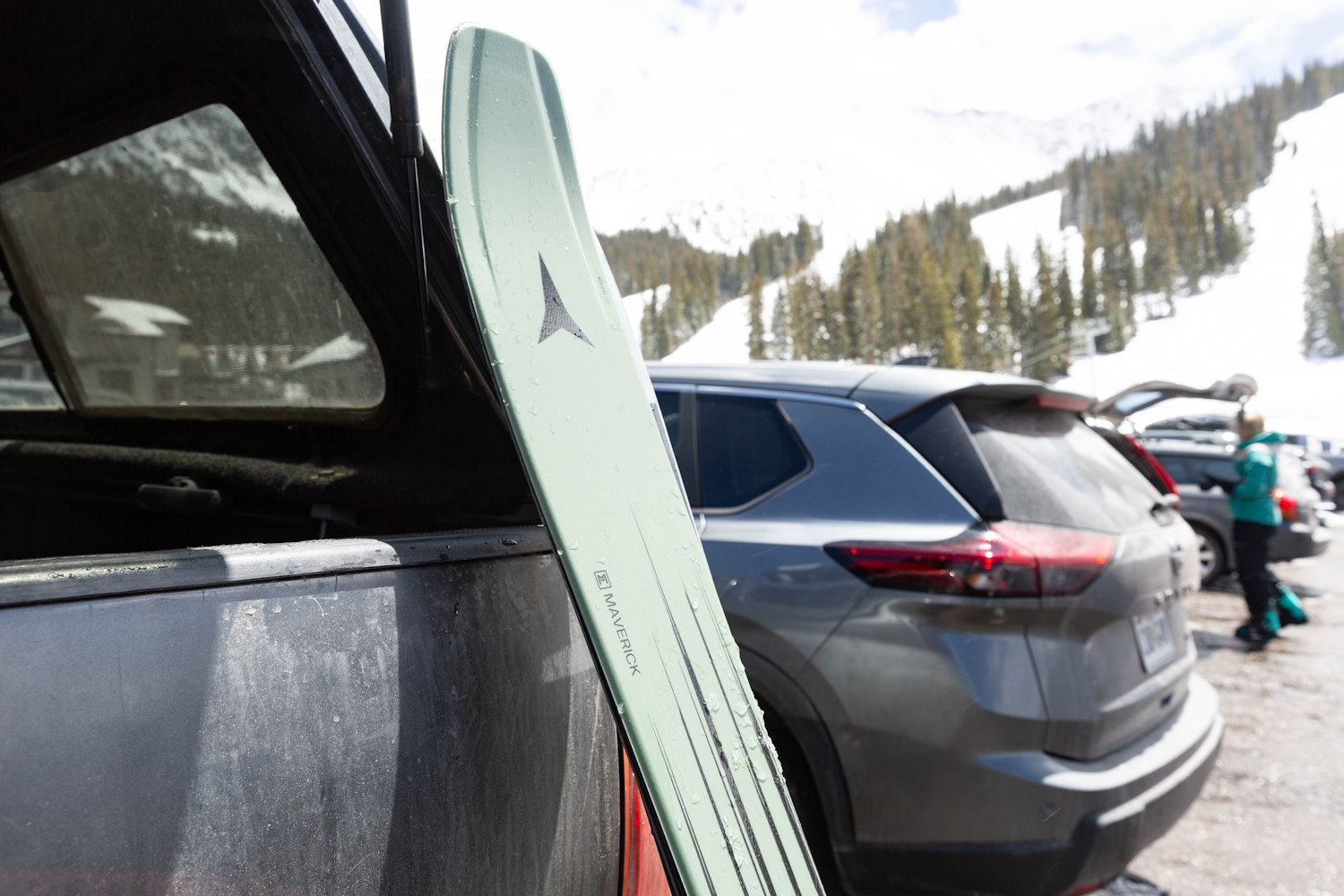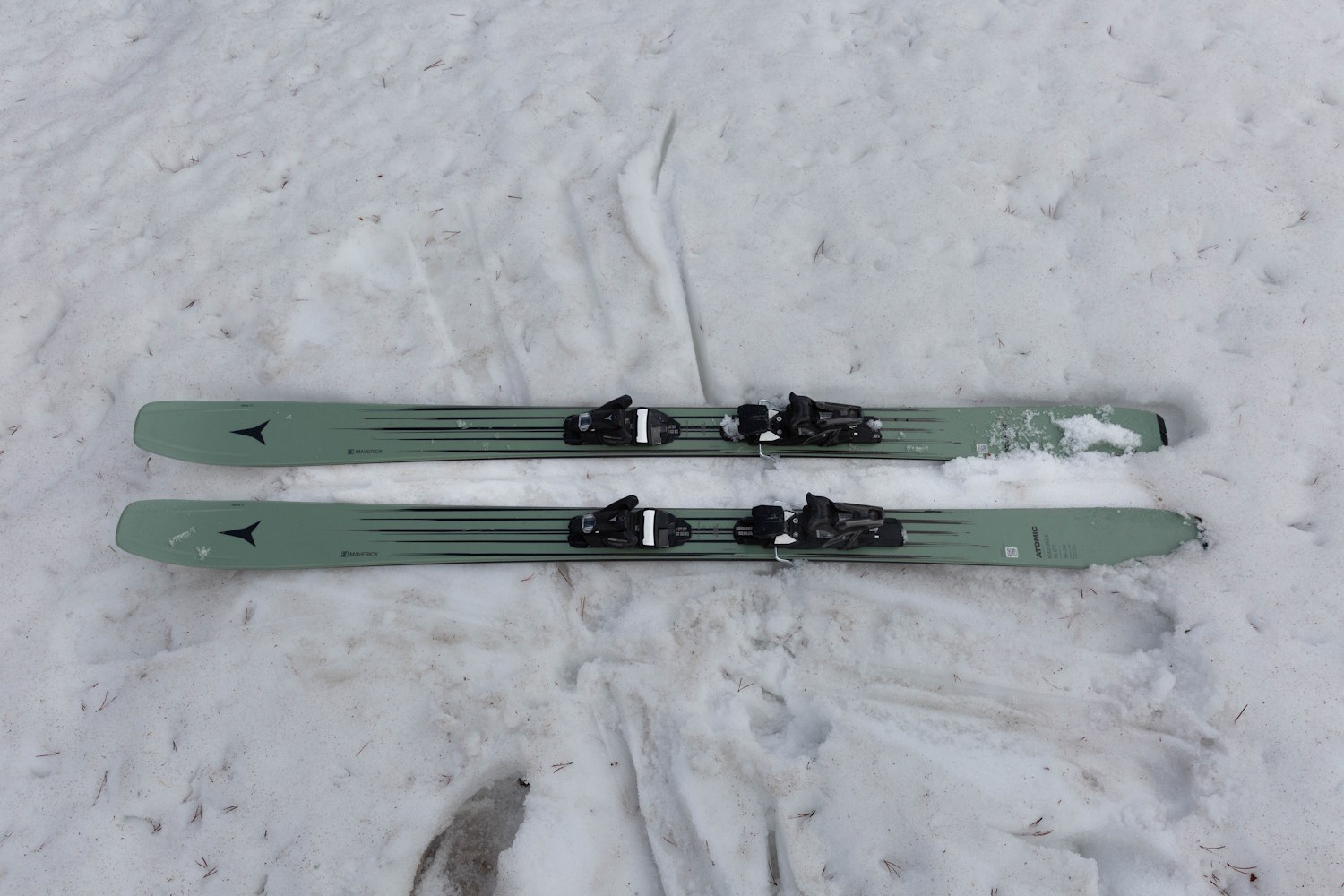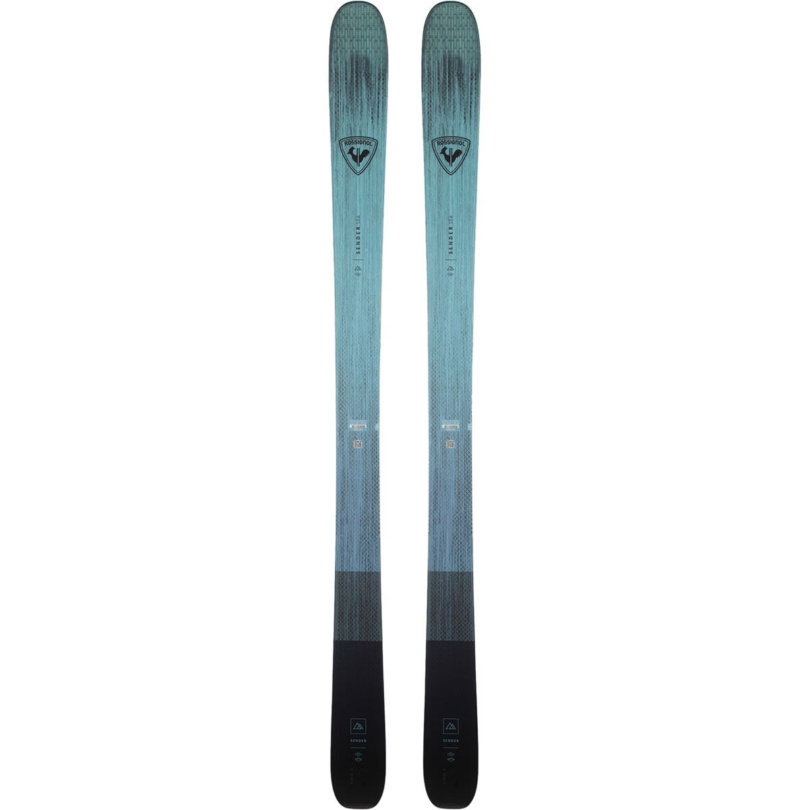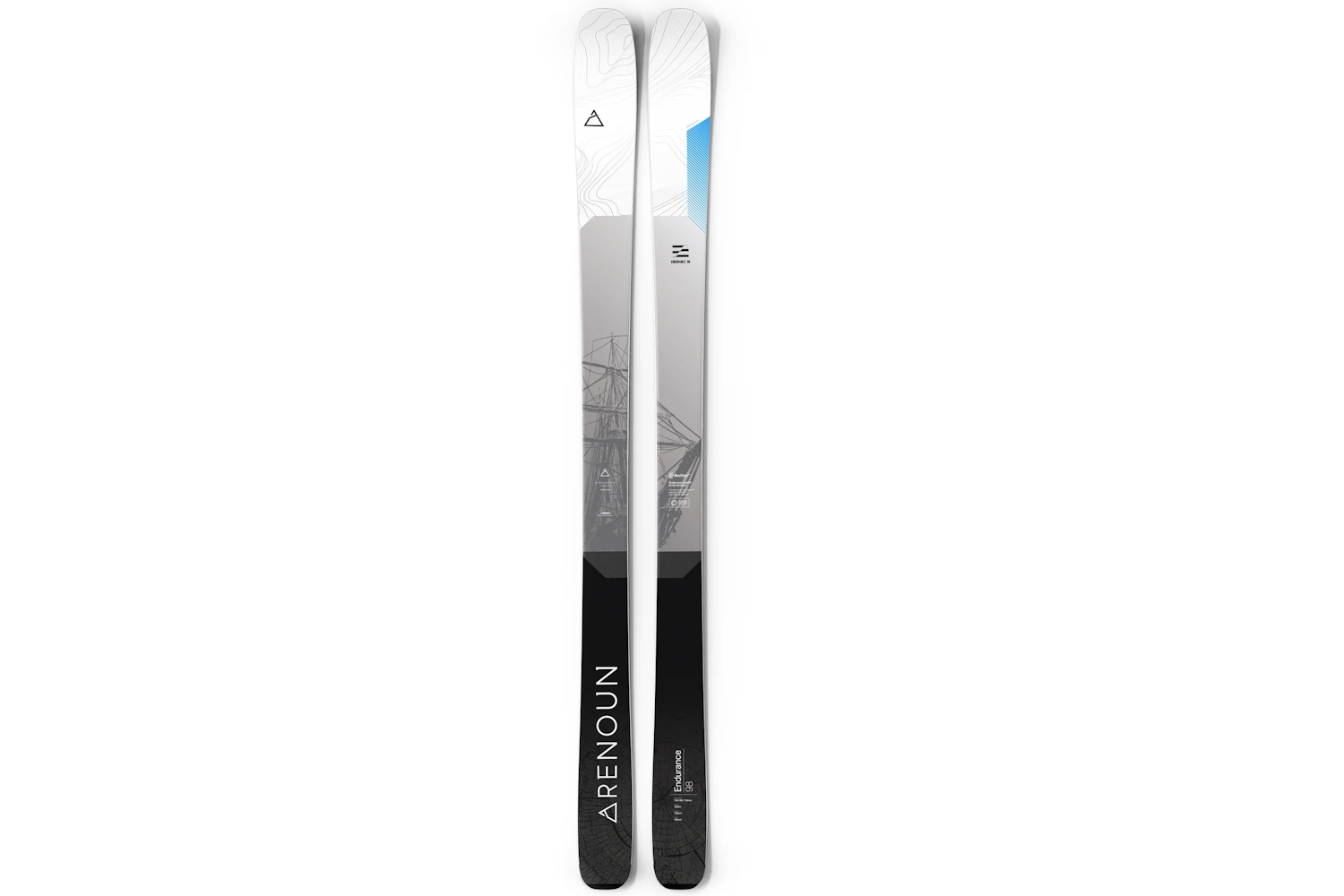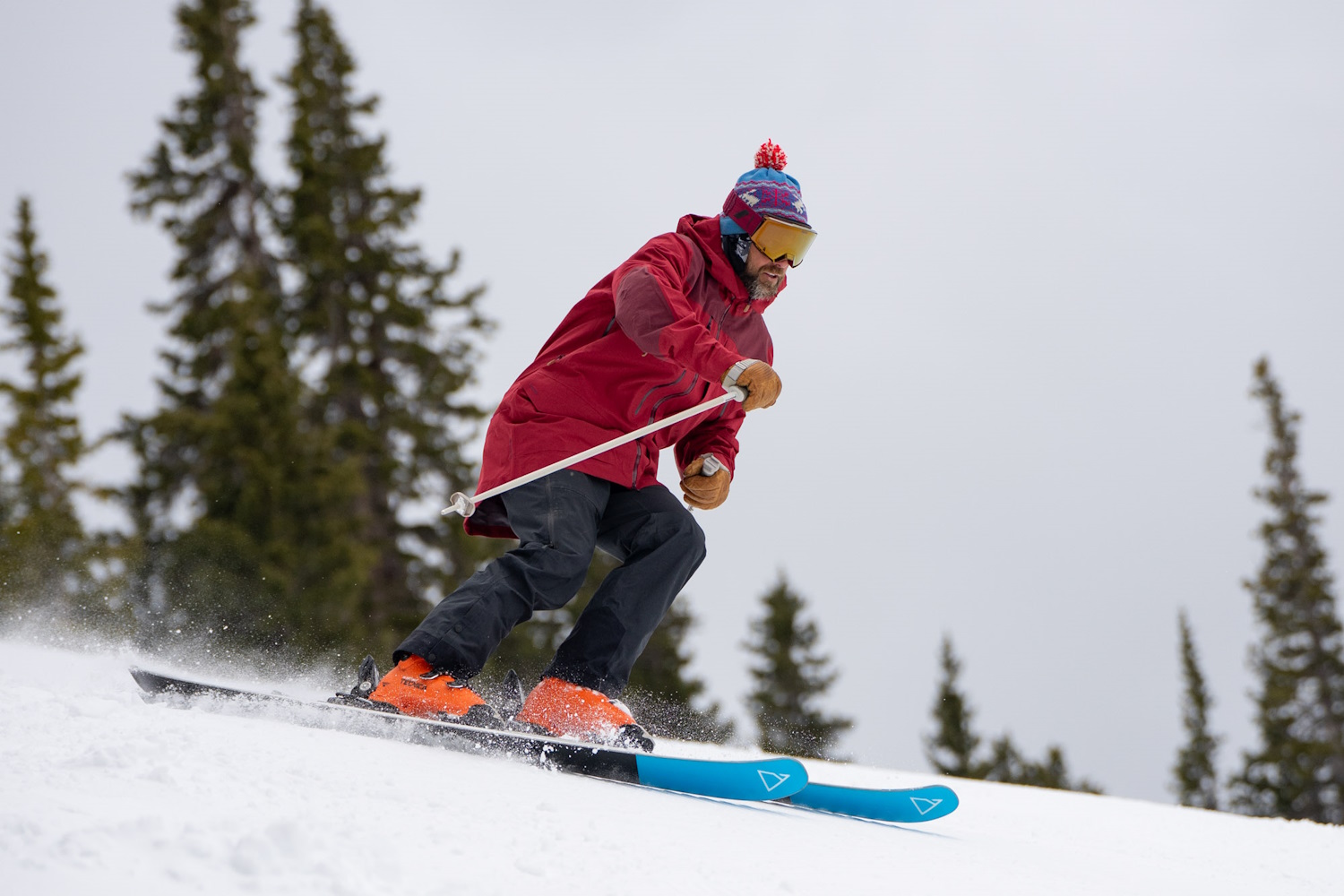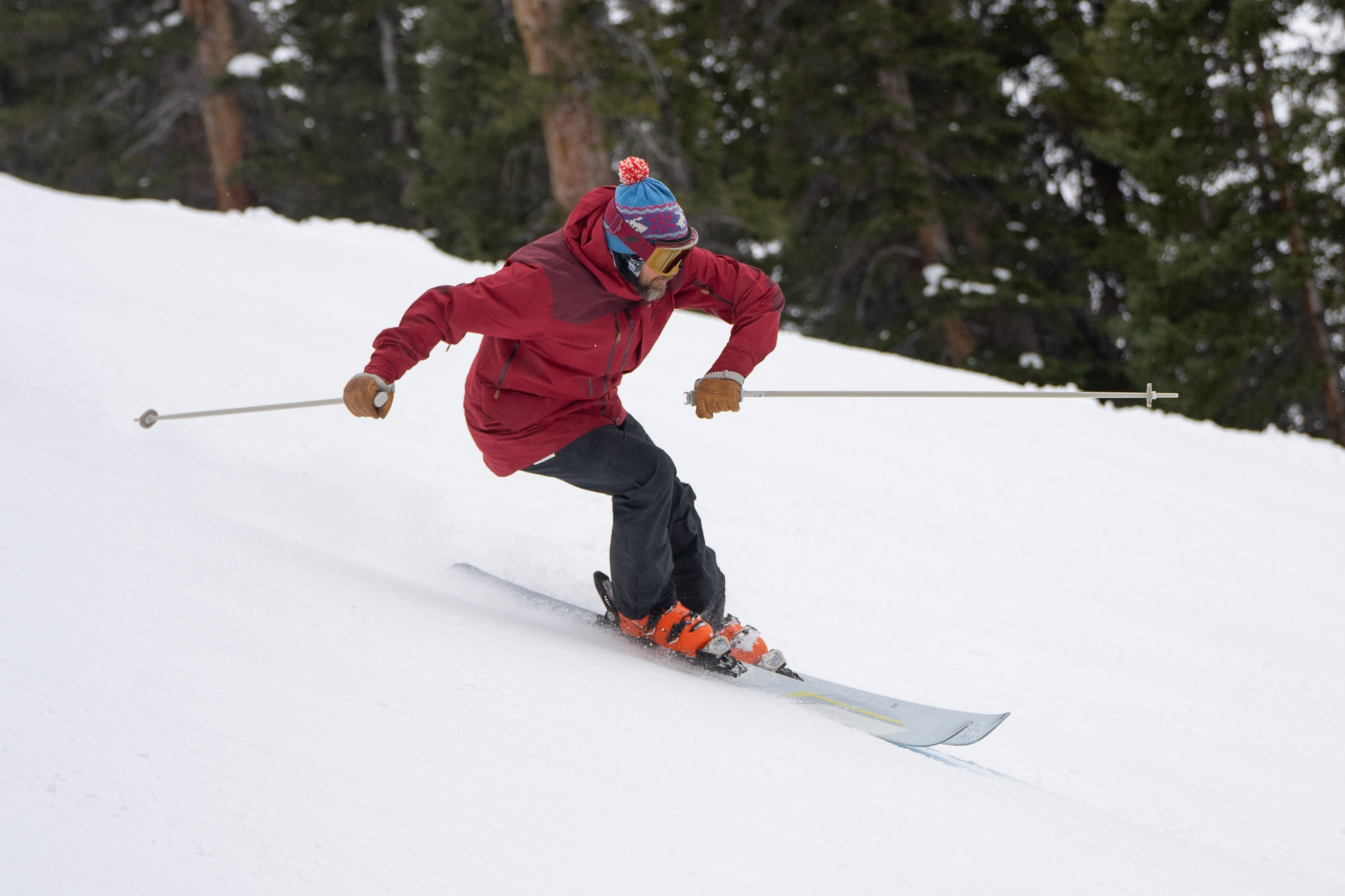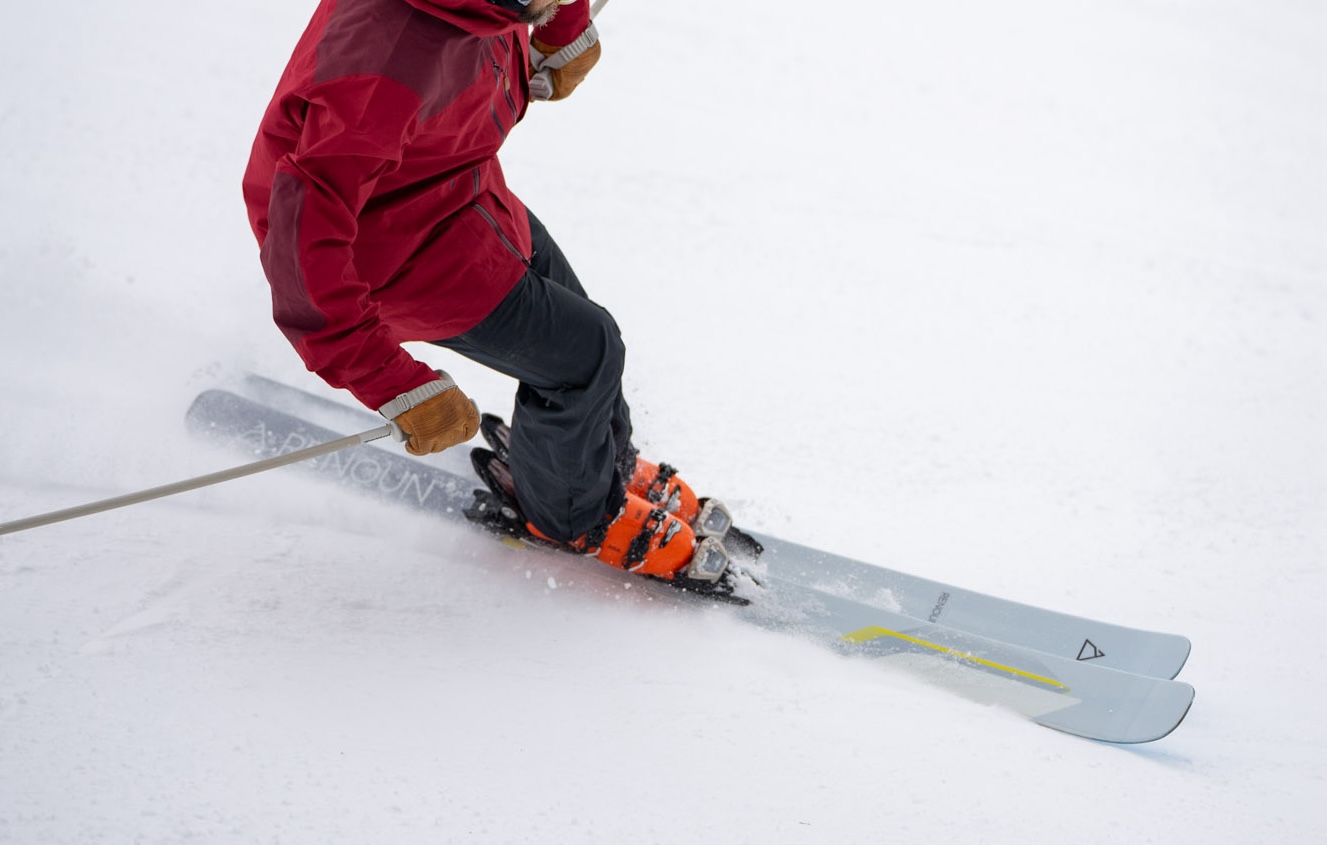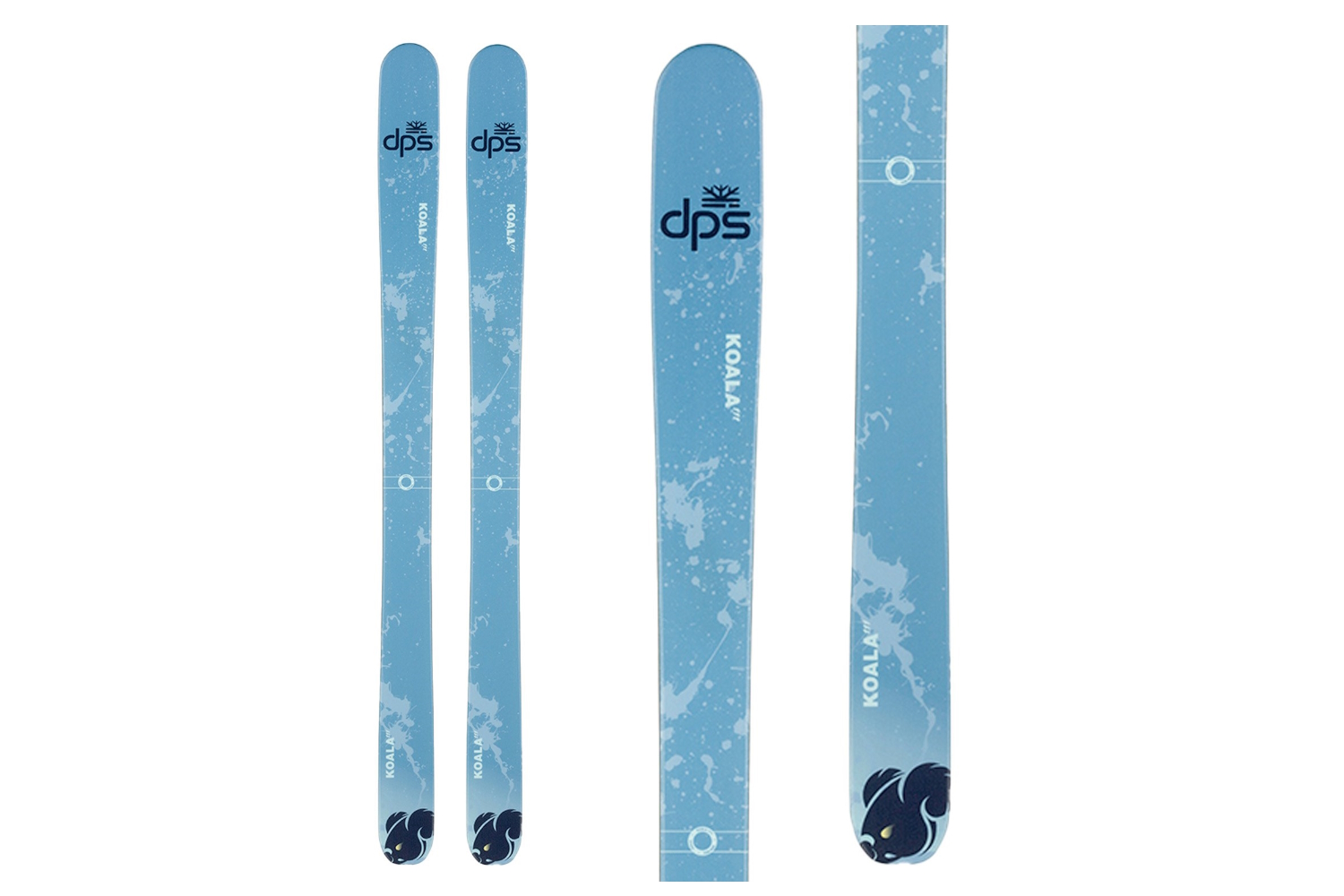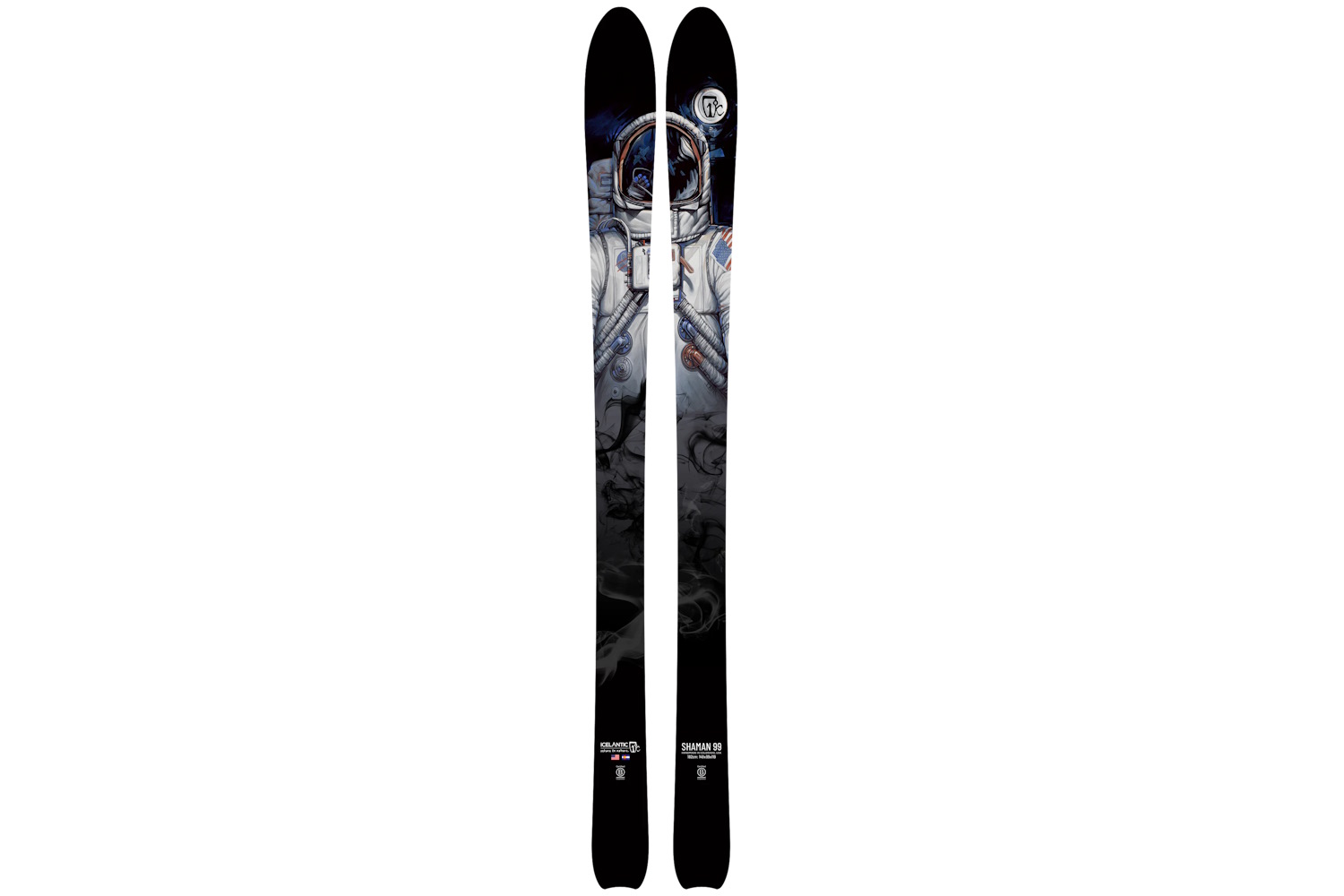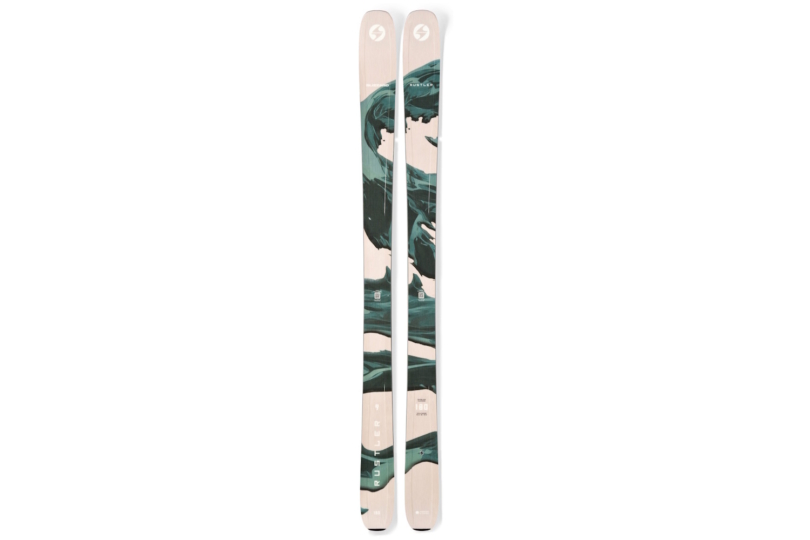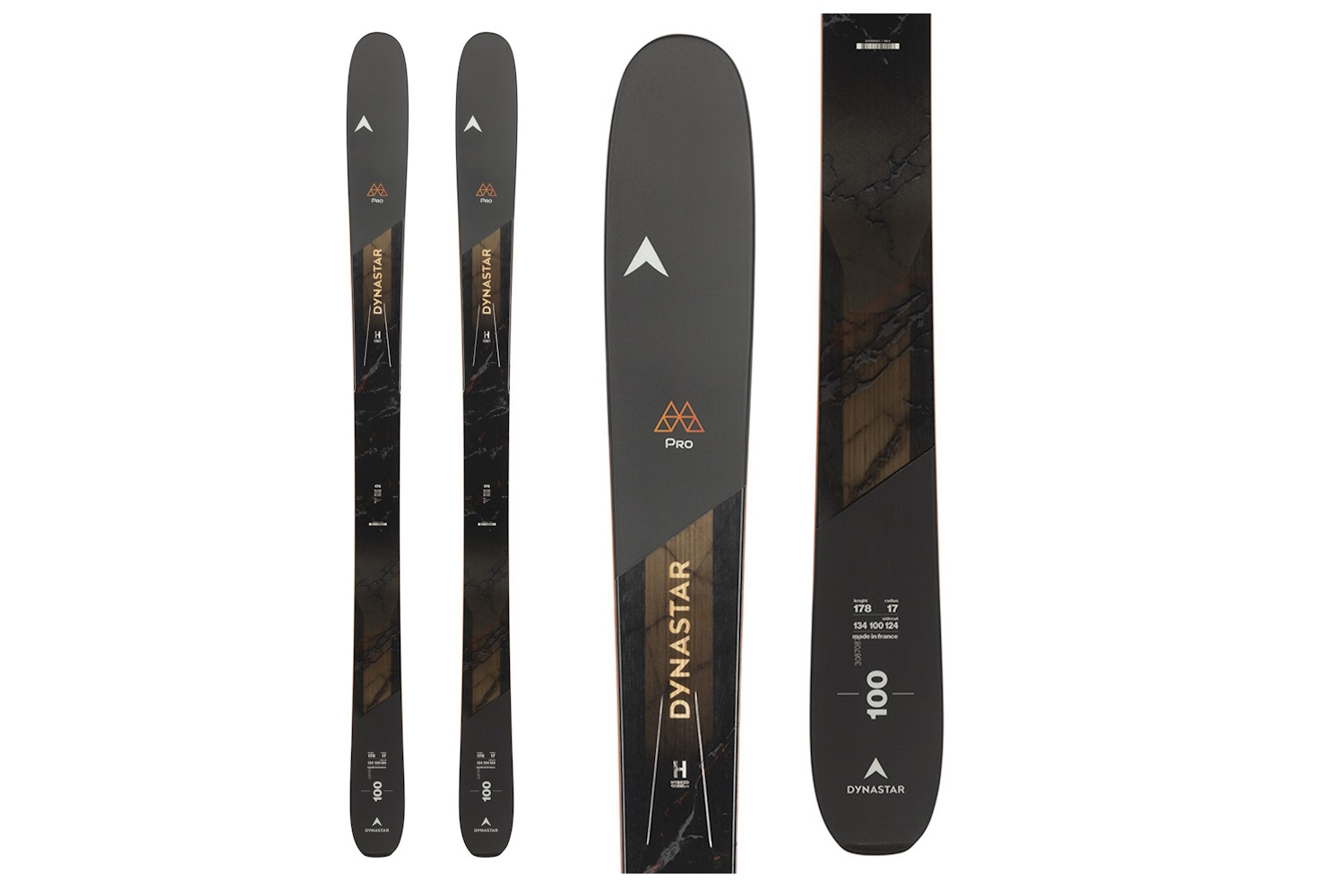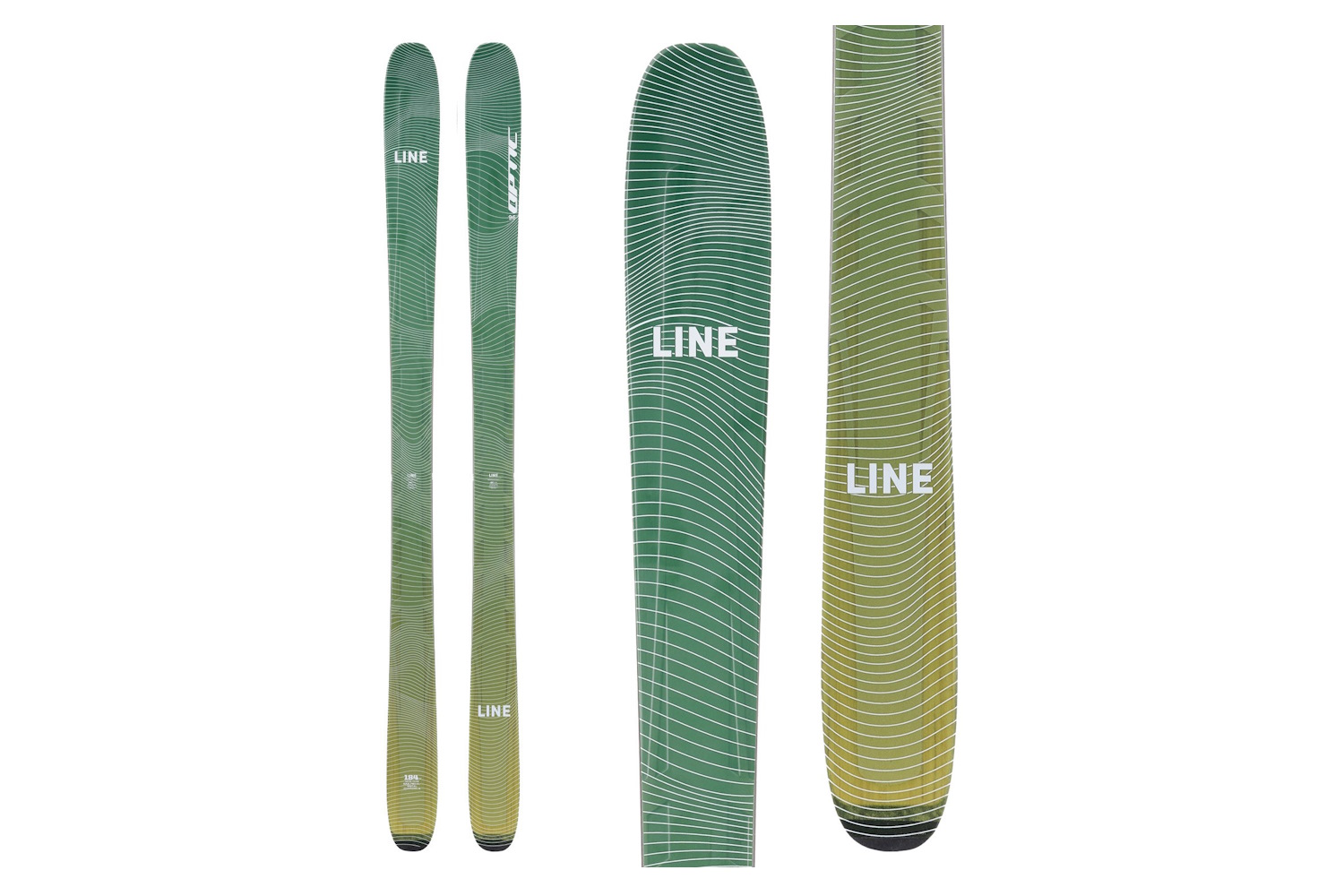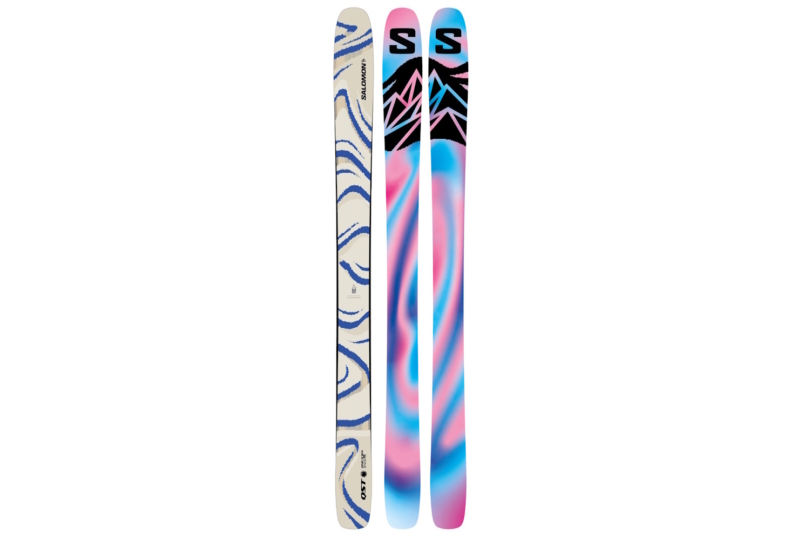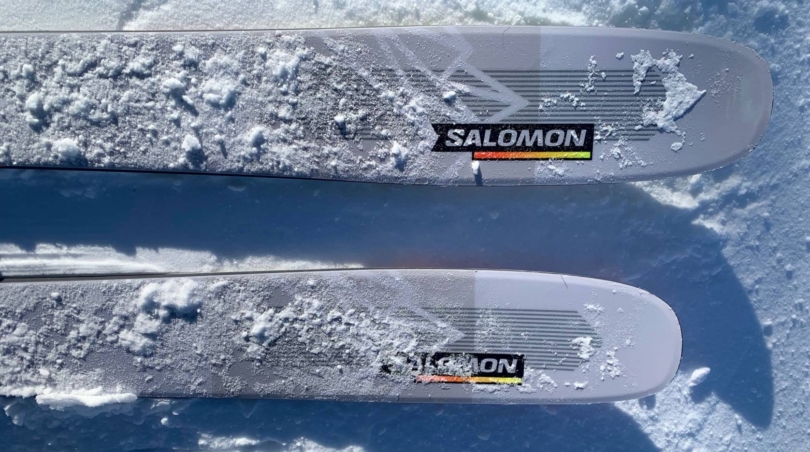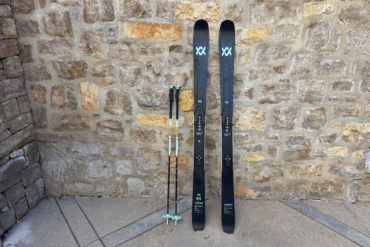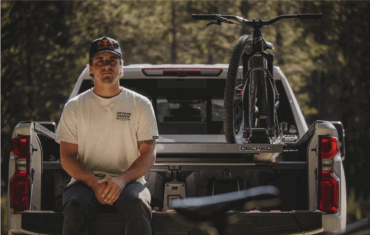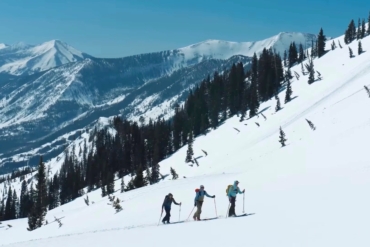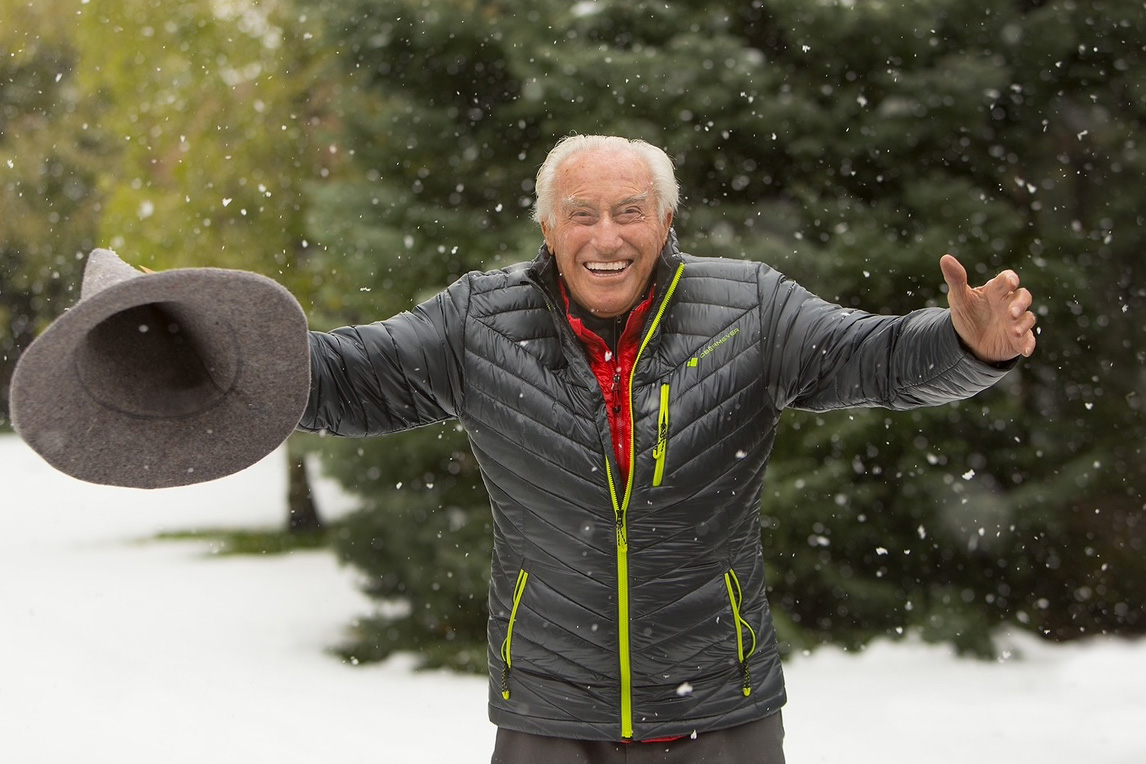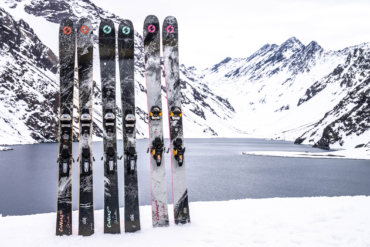With all-mountain skis, versatility is the name of the game. Though the definition of “all-mountain” varies by retailer and brand, all of the skis on this list perform well across a broad range of skiing styles and snow conditions.
Our selections include the best all-around, the best for beginners, and the most playful. Fast, aggressive skiers might prefer a ski like the Dynastar M-Pro 100 Ti, while the Salomon QST 106 is suitable for skiers who want a playful, wide tool to charge everything but ice.
Editor’s Note: We updated our All-Mountain Skis guide on October 28, 2025, to include the Atomic Maverick 96 CTI. We also adding detailed ratings to help you compare each ski to find the best for your needs.
The Best All-Mountain Skis of 2025-2026
Völkl Mantra M7
-
Versatility
8.5
-
Stability
8.5
-
Ski Edges & Ice Grip
7.0
-
Playfulness & Powder
4.5
- Profile: Camber underfoot, rocker in the tip and tail
- Sidecut radius: 19m (184)
- Best for: Intermediate to expert skiers looking for one ski to do it all
- Waist widths (mm): 96
- Sizes (cm): 163, 170, 177, 184, 191
Pros
- This versatile ski can handle anything the mountain throws at it
- It’s the closest thing to a one-ski quiver on the market
Cons
- Chattery on very hard snow
- If you ski a lot of ice, look for something with metal construction
Rossignol Experience 76 Skis + Xpress 10 GW Bindings
-
Versatility
6.9
-
Stability
6.9
-
Ski Edges & Ice Grip
5.0
-
Playfulness & Powder
6.9
- Profile: Rocker in the tail, mild camber underfoot
- Sidecut radius: 16m (size 176)
- Best for: Beginners looking to progress and develop new skills
- Waist widths (mm): 76
- Sizes (cm): 152, 160, 168, 176
Pros
- Great value
- Progression-oriented
Cons
- Not ideal for softer snow and deep powder
Nordica Unleashed 114
-
Versatility
8.0
-
Stability
9.0
-
Ski Edges & Ice Grip
9.0
-
Playfulness & Powder
8.0
- Profile: Camber underfoot, rocker in the tip and tail
- Sidecut radius: 20.4m (size 186)
- Best for: Hard-charging powder-chasers
- Waist widths (mm): 98, 108, 114
- Sizes (cm): 174, 180, 186, 191
Pros
- Stable in mixed chop and crud
- Lightweight, quick edge-to-edge
- Good float in fresh snow
Cons
- Unforgiving for beginners
- Pricey
Elan Ripstick 102 Black
-
Versatility
8.0
-
Stability
7.5
-
Ski Edges & Ice Grip
7.9
-
Playfulness & Powder
8.5
- Profile: Camber underfoot, rocker in the tip and tail
- Sidecut radius: 18.2m (size 186)
- Best for: Skiers looking for a playful daily driver for off-piste
- Waist widths (mm): 88, 96, 106, 116
- Sizes (cm): 161, 168, 175, 182, 189
Pros
- Easy, intuitive to ski
- Lightweight, maneuverable
- Good edgehold for wider ski
Cons
- Less stable at speed
- High price tag
Atomic Bent 110
-
Versatility
9.0
-
Stability
8.0
-
Ski Edges & Ice Grip
8.0
-
Playfulness & Powder
9.0
- Profile: Camber under foot, tip and tail rocker, convex HRZN tip and tail for 10% additional surface area
- Sidecut radius: 18m (size 188)
- Best for: Playful big mountain skiing on soft snow
- Waist widths (mm): 120, 100, 90, 85
- Sizes (cm): 172, 180, 188
Pros
- A super fun ski that loves to shift, pivot, and surf down the mountain
- Poppy and capable in the air
- Rides over soft snow adding to the playfulness
Cons
- Doesn’t charge through variable snow as well as stiffer skis
Scott Sea 108 Ski
-
Versatility
8.0
-
Stability
8.0
-
Ski Edges & Ice Grip
8.0
-
Playfulness & Powder
7.0
- Profile: Rocker/camber/rocker with horizontal rocker
- Sidecut radius: 19 m (184 cm)
- Best for: Freeride, soft snow
- Waist widths (mm): 88, 98, 108, 116
- Sizes (cm): 168, 176, 184, 192
Pros
- Versatile soft snow performance
- Mid-tier price point
- Durable construction
Cons
- Skis somewhat short in powder
- Imprecise on hard snow
Armada ARV 100 Ski
-
Versatility
7.5
-
Stability
7.5
-
Ski Edges & Ice Grip
7.5
-
Playfulness & Powder
8.5
- Profile: Twin tip, rocker/camber/rocker
- Sidecut radius: 18.7 m (186 cm)
- Best for: Park/freestyle
- Waist widths (mm): 88, 96, 105, 115
- Sizes (cm): 158, 165, 172, 179, 186
Pros
- Playful, energetic build for freestyle skiing
- Friendly mid-tier price point
- Durable construction
Cons
- Low speed limit
- Limited soft snow performance
Other All-Mountain Skis We Love to Shred
-
Versatility
7.5
-
Stability
7.0
-
Ski Edges & Ice Grip
7.0
-
Playfulness & Powder
6.5
- Profile: Rocker/camber/rocker
- Sidecut radius: 16.5 m (size 180)
- Best for: All-mountain
- Waist widths (mm): 94, 100, 106
- Lengths (cm): 156, 164, 172, 180, 188
Pros
- Capable carver away from ice
- Outperforms its width in soft snow
- Energetic flex
Cons
- Has a speed limit
- Narrow for powder skiing
-
Versatility
8.0
-
Stability
9.0
-
Ski Edges & Ice Grip
9.0
-
Playfulness & Powder
8.0
- Profile: Rocker/camber/rocker (20/65/15)
- Sidecut radius: 18 m (size 186)
- Best for: Directional speed-lovers
- Waist widths (mm): 88, 96, 105, 115
- Sizes (cm): 165, 172, 179, 186
Pros
- Skis better than its specs in soft snow
- Stable at high speeds
- Good carving performance
Cons
- Limited freestyle chops
- Expensive
-
Versatility
8.5
-
Stability
7.5
-
Ski Edges & Ice Grip
7.5
-
Playfulness & Powder
8.5
- Profile: Directional Rocker
- Sidecut radius: 21 m
- Best for: The intermediate to expert all-mountain skier who loves powder and prefers a traditional, directional shape
- Waist widths (mm): 104, 106, 108
- Sizes (cm): 180, 187, 194
Pros
- Incredibly maneuverable and easy to ski
- Versatile performance
Cons
- Shorter effective edge
- Not the best for carving
-
Versatility
7.0
-
Stability
6.0
-
Ski Edges & Ice Grip
7.0
-
Playfulness & Powder
5.0
- Profile: Camber underfoot, rocker in the tip and tail
- Sidecut radius: 17m (size 184)
- Best for: Intermediate to advanced frontside-first skiers
- Waist widths (mm): 98
- Sizes (cm): 163, 170, 177, 184
Pros
- Stable carving performance
- Won’t tire out lighter or novice skiers
- Capable of various turn sizes
Cons
- Gets thrown around at speed in crud
- Limited in deep snow
-
Versatility
8.0
-
Stability
6.0
-
Ski Edges & Ice Grip
8.0
-
Playfulness & Powder
7.5
- Profile: Camber underfoot, 20% rocker tip and 20% rocker tail
- Sidecut radius: 18m
- Best for: Freestyle skiers in powdery conditions
- Waist widths (mm): 103, 118
- Sizes (cm): 168, 176, 184, 189
Pros
- Playful, enjoys popping off features, smearing large turns, and anything inbetween
- Arcs well on edge, rocker tail allows you to pivot whenever
- Great soft snow ski
Cons
- Low speed, small turns are quite difficult with this underfoot width
- Stiffness of the ski make it tricky to handle in tight spots
-
Versatility
8.0
-
Stability
9.0
-
Ski Edges & Ice Grip
9.0
-
Playfulness & Powder
7.0
- Profile: Camber underfoot, rocker in the tip and tail
- Sidecut radius: 24m (size 188)
- Best for: Hard-charging frontside skiers
- Waist widths (mm): 84, 88, 94, 102
- Sizes (cm): 176, 182, 188, 192
Pros
- Excellent edge hold when carving
- Damp in chop and crud
- Supports various turn sizes
Cons
- Sinks in light pow
- Expert-only
-
Versatility
8.0
-
Stability
7.0
-
Ski Edges & Ice Grip
8.0
-
Playfulness & Powder
8.0
- Profile: Large rocker tip, camber underfoot, flat tail
- Sidecut radius: 15m
- Best for: All mountain skiers that love laying edges over
- Waist widths (mm): 110
- Sizes (cm): 168, 176, 182
Pros
- Can make many different turn shapes
- Shines in almost all conditions
Cons
- Not a great ski for skiing backwards (if that’s your thing)
- Tips flap at high speed
-
Versatility
7.9
-
Stability
9.0
-
Ski Edges & Ice Grip
8.0
-
Playfulness & Powder
7.0
- Profile: Rocker-camber-rocker
- Sidecut radius: 14 m, 15.5, 17, 18.5
- Best for: Groomer-leaning all-mountain skiers looking for a stable ride
- Waist widths (mm): 96
- Sizes (cm): 164, 172, 180, 188
Pros
- Incredibly stable and damp
- Great on groomers and hardpack
Cons
- A bit slow edge-to-edge in bumps
- Sacrifices a bit of maneuverability for stability
-
Versatility
8.0
-
Stability
9.0
-
Ski Edges & Ice Grip
9.0
-
Playfulness & Powder
6.0
- Profile: Directional rocker, camber
- Sidecut radius: 15 m (162), 16 (170), 17 (178), 18 (186)
- Best for: Long GS-style turns and fast skiing
- Waist widths (mm): 98, 99, 100
- Sizes (cm): 162, 170, 178, 186
Pros
- Great on hardpack and for those who like high speeds
- Excels in a variety of snow conditions
Cons
- Not the most maneuverable
- Not a great choice for beginners
-
Versatility
8.9
-
Stability
8.9
-
Ski Edges & Ice Grip
8.9
-
Playfulness & Powder
7.0
- Profile: Rocker-Camber-Rocker
- Sidecut radius: 18 m
- Best for: Intermediate to expert skiers who prefer long radius turns and don’t shy away from any part of the mountain
- Waist widths (mm): 96
- Sizes (cm): 163, 170, 177, 184
Pros
- Exceptional carving ability, for their weight and stiffness
- Handled most conditions and terrain on the mountain well
Cons
- Medium-long turning radius makes them less nimble
-
Versatility
8.5
-
Stability
8.0
-
Ski Edges & Ice Grip
7.5
-
Playfulness & Powder
8.5
- Profile: 25% tip rocker / 58% camber / 17% tail rocker
- Sidecut radius: 19m (size 181)
- Best for: Fast skiers who want a hard charger ideal for western mountains
- Waist widths (mm): 106
- Sizes (cm): 157, 165, 173, 181, 189
Pros
- Quick edge-to-edge
- Stable
- Confidence-inspiring
Cons
- Handles groomers well but doesn’t carve as well as skis with harsher sidecut
All-Mountain Skis Comparison Chart
Scroll right to view all of the columns: Price, Profile, Sidecut Radius, Best For, Waist Width, Sizes.
| All-Mountain Skis | Price | Profile | Sidecut Radius | Best For | Waist Width | Sizes |
| Volkl M7 Mantra | $850 | Rocker-Camber-Rocker | 19m (184) | Intermediate, Expert | 96 | 163, 170, 177, 184, 191 |
| Salomon QST 106 | $650 | Rocker-Camber-Rocker | 19m (181) | Expert | 92, 98 | 167, 174, 181, 188 |
| Atomic Bent 110 | $750 | Rocker-Camber-Rocker | 18m (188) | Intermediate, Expert | 120, 100, 90, 85 | 172, 180, 188 |
| Scott Sea 108 Ski | $750 | Rocker/camber/rocker with horizontal rocker | 19 m (184 cm) | Freeride, soft snow | 88, 98, 108, 116 | 168, 176, 184, 192 |
| Armada ARV 100 Ski | $700 | Twin tip, rocker/camber/rocker | 18.7 m (186 cm) | Park/freestyle | 88, 96, 105, 115 | 158, 165, 172, 179, 186 |
| Salomon QST 94 Skis | $700 | Rocker/camber/rocker | 16.5 m (size 180) | All-mountain | 94, 100, 106 | 156, 164, 172, 180, 188 |
| Atomic Maverick 96 CTI Skis | $750 | Rocker/camber/rocker (20/65/15) | 18 m (size 186) | Directional speed-lovers | 88, 96, 105, 115 | 165, 172, 179, 186 |
| DPS Koala 111 | $900 | Rocker-Camber-Rocker | 18m (168) | Expert | 103, 118 | 168, 176, 184, 189 |
| Icelantic Shaman 99 | $849 | Rockered tip, camber underfoot, flat tail | 15m (176) | Expert | 110 | 168, 176, 182 |
| Blizzard Rustler 9 | $750 | Rocker-Camber-Rocker | 14m, 15.5, 17, 18.5 | Intermediate, Advanced, Expert | 96 | 164, 172, 180, 188 |
| Dynastar M-Pro 100 Ti | $900 | Directional Rocker, camber | 15m (162), 16 (170), 17 (178), 18 (186) | Expert | 98, 99, 100 | 162, 170, 178, 186 |
| Line Optic 96 | $700 | Rocker-Camber-Rocker | 18m (177) | Intermediate, Expert | 96 | 163, 170, 177, 184 |
| Rossignol Sender 106 Open | $900 | Directional Rocker | 21m (180) | Intermediate, Expert | 104, 106, 108 | 180, 187, 194 |
| Nordica Unleashed 114 | $900 | Rocker-Camber-Rocker | 20.4m (186) | Advanced, Expert | 98, 108, 114 | 174, 180, 186, 191 |
| Blizzard Anomaly 102 | $800 | Rocker-Camber-Rocker | 24m (188) | Advanced, Expert | 84, 88, 94, 102 | 176, 182, 188, 192 |
| Renoun Endurance 98 | $949 | Rocker-Camber-Rocker | 17m (184) | Intermediate, Advanced, Expert | 98 | 163, 170, 177, 184 |
| Elan Ripstick 102 Black | $950 | Rocker-Camber-Rocker | 18.2m (186) | Advanced, Expert | 88, 96, 106, 116 | 161, 168, 175, 182, 189 |
| Rossignol Experience 76 | $480 | Rocker-Camber-Rocker | 16m (176) | Beginners | N/A | 152, 160, 168, 176 |
How We Tested the Best All-Mountain Skis
Our Expert Testers
Contributor Justin Park tests and reviews gear from his home base in Breckenridge, Colorado, where he skis more than 100 days each season, split evenly between backcountry and resort days. From sub-zero January pow days to slushy June touring missions, he puts dozens of jackets, skis, boots, and pants through their paces at high elevation.
Among our ski testers is custom ski builder Albert Kim. Over the years, he has worked in many ski shops, testing hundreds of pairs of skis. He eventually worked for Wagner Custom Skis in Telluride, molding desired ski attributes into one-of-a-kind skis for customers. He enjoys being the first one out on steep, tight terrain and skiing as fast as he can.
Another past contributor to this guide is Editorial Director Sean McCoy. He’s an aggressive skier with 40 years of experience. McCoy started skiing at 4 years old, slogging across snow-covered golf courses with his parents on ancient wooden cross-country skis. That was in the 1970s. He now tends to favor wider skis in his home mountains in Colorado.
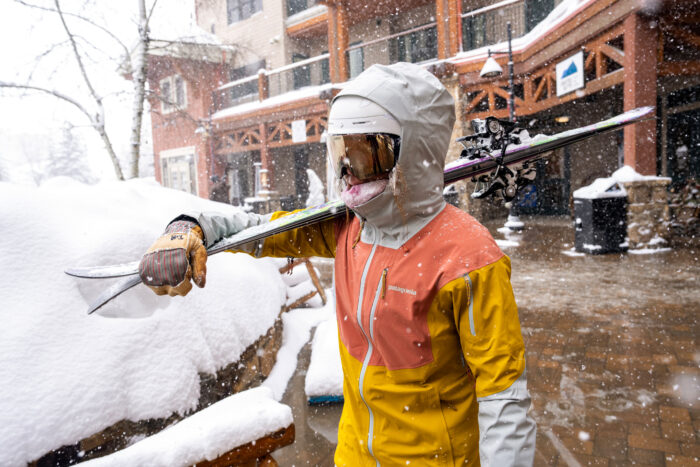
Our Testing Grounds
Our testers are based in Colorado and Utah and ski a range of resorts across the West, as well as backcountry turns.
The GearJunkie team meets for an annual on-snow test week to grind out turns and swap notes, including two previous gatherings at Crested Butte Mountain Resort, which is known for its expert terrain.
Our Testing Process
While testing skis, we assess a range of factors including each design’s stiffness, maneuverability, and playfulness as well as the ski’s energy, damping, chatter, weight, shape, edge hold, and turn initiation. The base and edge tune also influence how a ski performs. We considered what type of skier and conditions are the best fit for each ski.
In addition to our team’s field experience, we consider the most popular, innovative, award-winning, and bestselling skis on the market as well as a broad range of price points and a variety of features and applications.
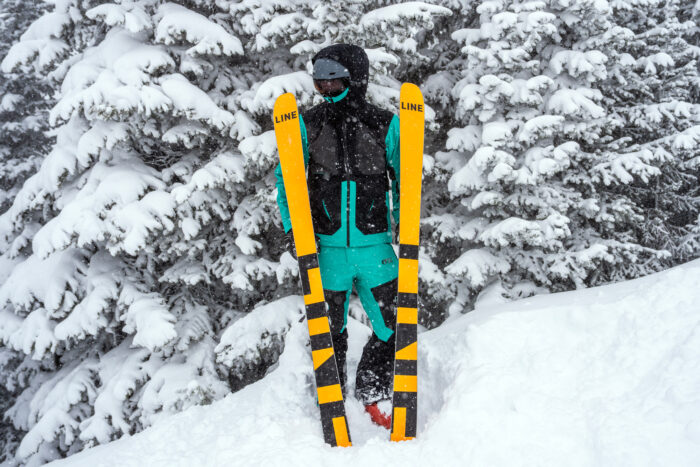
Finally, we meet with brands throughout the year to learn about top products. We carefully research these skis before selecting only the most promising for real-world testing.
The result of these hundreds of hours of work is the buyer’s guide you see before you. And we will update this guide multiple times each year to keep it timely and relevant to help you pick the best all-mountain skis for your needs.
Our All-Mountain Ski Rating System
To help skiers find the best pair, we evaluate each set of skis using four qualities to measure performance across conditions and terrain:
- Versatility examines how well skis transition between conditions — ice, crust, hardpack, chalk, corduroy, deep powder — and terrain from groomers and glades to rocky traverses and open bowls.
- Stability looks at how consistent and solid the ski feels when hitting the gas and its ability to resist chatter. The design’s ability to remain stable across ice is factored in, too.
- Ski Edges & Ice Grip inspects how aggressive the skis can bite into snow and ice, while also considering the effective edge angle. A good side bevel for All-Mountain skis is 2 degrees (88 degrees total) for a sharper grip that’s precise.
- Playfulness & Powder scopes out the forgiving nature of skis including the amount of flex and the distribution of the flex. Softer flex is more playful, and a gradual flex provides a surfier feel. Adding rocker to the profile increases personality, as does a lighter weight or twin shape. Those qualities plus a longer, wider tip and wider waist boost flotation in powder.
The Overall Rating is an overall impression after in-depth field testing and cross-comparison. That halo digit includes additional factors such as the price point, quality of materials, sustainability, and durability.
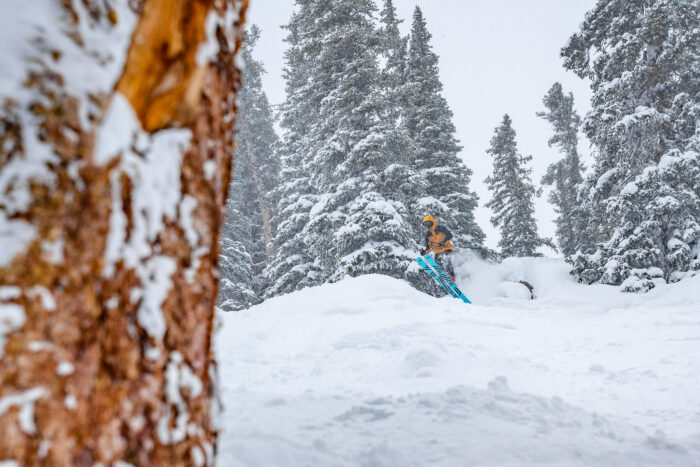
How to Choose the Best All-Mountain Skis
All-mountain skis are designed to handle a broad range of skiing styles and snow conditions. If a single-quiver ski exists, it’s likely an all-mountain ski.
What Does ‘All-Mountain’ Mean?
While some skis are made for a specific purpose — racing or ripping through the terrain park, for example — all-mountain skis are much more versatile. With any of the excellent skis on this list, you’ll be free to roam around the resort as you please, from the trees to the groomers and back again.
There is no official set of traits and specs a ski must have to earn the all-mountain title. Many brands and retailers have their own unique all-mountain criteria. Generally, versatile skis that can serve as an effective quiver of one have a few key characteristics in common.
First, most men’s all-mountain skis have a waist width between 75 mm and 105 mm. This spectrum represents the middle ground between super-narrow and super-wide skis — which is perfect for all-mountain use. Though, some all-mountain skis are even wider, which we dive into below: check out “powder-leaning all-mountain skis.”
Second, most skis in this category have a relatively traditional profile. With camber underfoot and some degree of rocker at the tip and the tail, a traditional profile offers a high level of usability from the fresh powder to the hardpack.

Different Types of All-Mountain Skis
All of the skis on this list prioritize versatility and can readily venture onto all parts of the mountain. Still, “all-mountain” is ultimately a spectrum that contains multiple subcategories of skis. Many skiers like to explore the whole mountain and still maintain a preference for a certain style of skiing.
Additionally, depending on where you live, you may be dealing with certain types of snow conditions on a regular basis. In these cases, it’s very helpful to have an all-mountain ski with design elements that best support your specific personal or place-based needs.
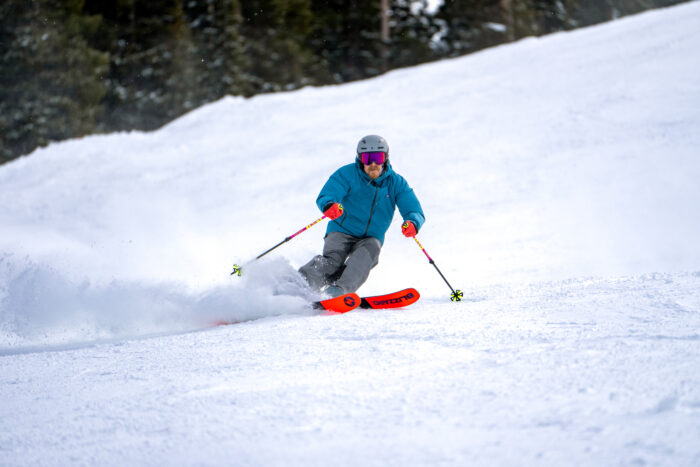
Frontside (Groomer-Leaning) All-Mountain Skis
Skis in this category will perform at their best on groomed runs and firm snow conditions. Typically, groomer-leaning all-mountain skis have a relatively narrow waist width between 75 mm and 100 mm.
Skis in this category will also prioritize edge hold, stiffness, and high-speed stability. While groomer-leaning all-mountain skis tend to sacrifice some performance and float in the deep powder, they’re great for hard carving and speeding down firm runs with minimal chatter.
This category is especially worth considering for skiers in the Midwest and East Coast regions.
If you’re a more casual skier who prefers sticking to the marked runs, consider a softer frontside all-mountain ski such as the Atomic Bent 110 or 100. Softer skis are less demanding to ski for intermediates which lets more relaxed skiers stay out longer.
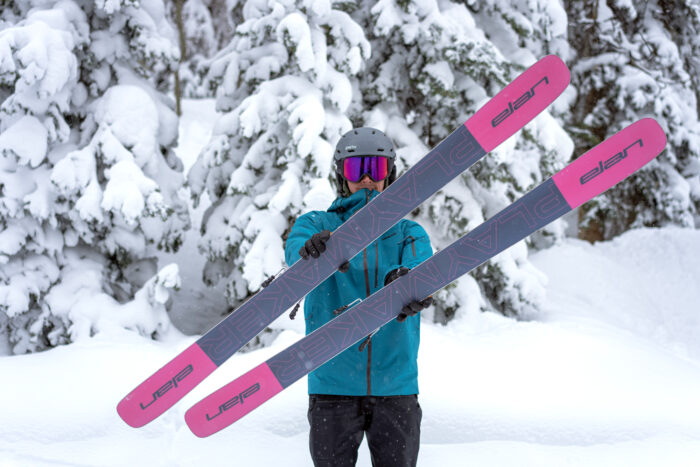
Backside All-Mountain Skis (All-Mountain Power Skis)
Backside (sometimes called off-piste or powder-leaning) all-mountain skis are the opposite of their narrower groomer-leaning counterparts. Generally, skis in this category have a waist width between 95 mm and 115 mm. If powder lines are your jam, these are the skis for you.
Wider skis used to be dedicated pow-day tools, but many Western skiers use fatter sticks all season long, and most backside all-mountain skis have enough side cut to permit serviceable carving on frontside groomed runs as well. Fatter platforms generally perform better in mixed off-piste conditions because they help you float and smear over and through soft snow, mixed chop, and even the dreaded breakable crust.
Skiers in regions with lots of snowfall should consider this category. For maximum floatation and a bit of added flex, check out powder-leaning all-mountain skis such as the Atomic Bent 110 or the DPS Koala. For a stiffer big mountain ski that still has great float, check out the Nordica Unleashed 114.

Freeride & Freestyle Skis
While all-mountain skis can be quite wide, freeride skis are another subset of design and they are all generally wider. That width is an asset for powder, ungroomed territory, and off-piste adventure. They also typically have an upturned tip for float and maneuverability.
What differentiates an all-mountain ski is that it thrives on groomers and also manages ungroomed terrain or powder. All-mountain skis are generally easier to control. Freeride skis excel more on ungroomed terrain and powder but can also be used on hardpack. The preference also comes down to a skier’s experience, style, and preference.
Freestyle skis are tailored for parks, tricks, half pipes, jumps, and jibs. Overall, you’ll see these designs are often shorter in length, symmetrical, lighter weight, poppy, and feature twin tips.
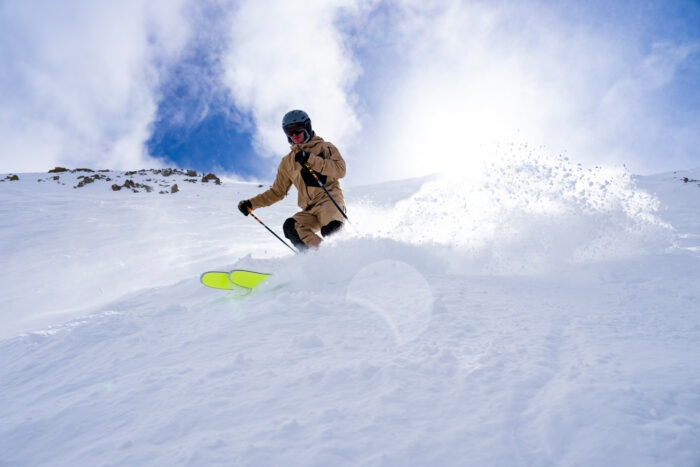
Waist Width: All-Mountain Skis
Waist width is the width of a ski at its narrowest point. All-mountain skis typically have a waist width between 75 mm and 105 mm, though Western pow-chasers can go even wider with all-mountain fat skis such as the Nordica Unleashed 114. Within the spectrum, narrower skis are generally better for carving on hard surfaces, while wider widths are better for floating through soft snow and powder.
Many ski models are available in multiple waist widths. For example, the Elan Ripstick 102 Black Editions are available in waist widths of 102 mm, 96 mm, and 94 mm. For each ski on this list, we’ve listed all the available waist widths.
The “all-mountain” category includes skis that range widely from as narrow as 75mm for groomer-focused carving all-mountain skis to 118mm for pow-first flotation in an all-mountain soft-snow model. We’ve divided this broad grouping of all-rounders into subcategories that can help you understand an appropriate width for your style of skiing.
- All-Mountain (Groomers): 75 to 90 mm
- All-Mountain (Midwest/East Coast): 80 to 95 mm
- All-Mountain (Western): 90 to 115 mm
- All-Mountain (Powder): 100 to 118 mm
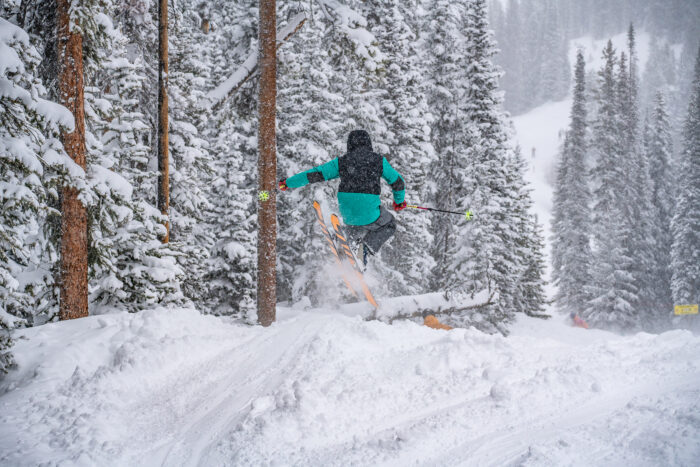
Ski Length
Ski length is a major consideration, and most of the models on this list are available in multiple lengths. In the past, a skier’s height would determine their ideal ski length. These days, the process is significantly more complicated.
While skier height remains an important factor, there are many other considerations for identifying the proper ski length. Shorter skis are easier to handle, which makes them a good choice for beginners. Shorter skis are also more nimble for quick turns if you’re a tree hound or love bumps.
The “effective edge” of a ski can also make a ski feel longer or shorter depending on where the widest part of the ski is relative to the tip and tail ends of the ski. Skis with shorter effective edges relative to their length will feel shorter when turning than more traditional skis, whose effective edge often extends to nearly the end of the ski.
This means that for skis with short effective edges relative to their length, you may want to size up from your normal length. Likewise, skis with long effective edges can be skied in shorter lengths comfortably and may have length ranges that feature shorter options overall. For example, the Renoun Endurance 98 skis have fairly long effective edges and top out at 184 cm but also come in 177, 170, and 163cm lengths.
Longer skis have more surface area, which means that they feel more stable at high speeds and float better in powder. The Blizzard Anomaly 102 skis are aimed at advanced skiers looking for stability at speed, and they come in relatively longer lengths of 176, 182, 188, and 192.
A skier’s weight may have an impact on a ski’s flex and power transfer. This sizing chart is an effective tool that will help you consider all of the relevant factors.

Ski Profile: Camber vs. Rocker
A ski’s profile is a major contributor to its overall performance. Today, the market is full of skis with all kinds of different profiles, from traditional to experimental and everything in between.
Skis with a more traditional camber profile are shaped like an upside-down letter “C” and rise up underneath the foot, making contact with the ground at the tip and the tail. While skiing, your body weight pushes the base of the ski against the snow.
During turns, the camber shape provides some lift and pop, which propels you into your next turn. For pure carving purposes, traditional camber is still the leading ski profile, and many skis on this list feature some variation on the traditional camber shape.
A rocker profile is the opposite and shaped like a banana — the tip and tail of the ski are lifted higher than the underfoot area. Rocker profiles are newer to the ski design world, but they have plenty of advantages.
When skiing in deep powder, a rocker profile offers extra float and creates a blissful surf-like experience. The downside of rocker profiles is they generally don’t hold an edge as well as traditional camber, so they aren’t ideal for precision carving on firm surfaces. But rocker (also called reverse camber) can be more forgiving while playing on snow and riding switch.
Many of the leading all-mountain skis have a hybrid profile that combines aspects of camber and rocker. To learn more about ski profiles and the nuanced differences between them, check out this handy video from snow sports retailer evo.
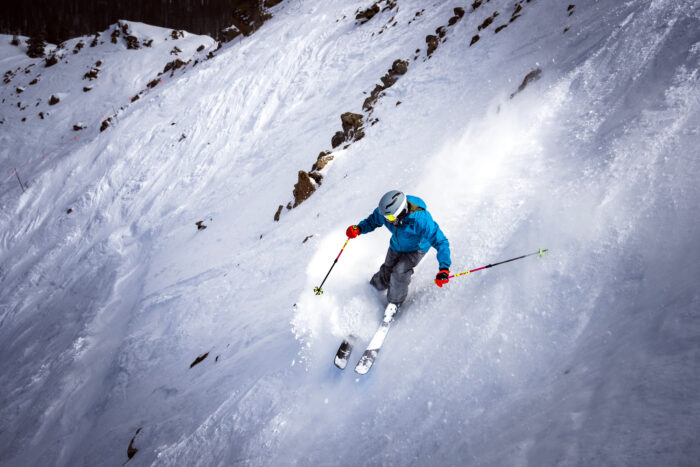
Stiffness & Flex: All-Mountain Skis
Ski stiffness is a major factor that seriously affects overall performance. On one end of the spectrum, soft skis are easier to maneuver, more playful, and best suited for beginner to intermediate skiers.
Freestyle skiers who love to hit boxes and rails may also want a relatively soft and flexible ski. One of the downsides of soft skis is they’re prone to be squirrelly and chatter at high speeds.
Stiff skis are preferred by intermediate, advanced, and expert skiers who crave speed and long, aggressive carves. Rigid designs offer more stability, which is essential for staying in control when skiing fast.
The downside of stiff skis is they require power and honed technique to steer properly. For this reason, we don’t recommend ultra-stiff skis to beginners.
Most all-mountain skis fall somewhere in the middle of the soft-to-stiff spectrum. Groomer-leaning skis are usually on the stiffer side to best support speed and stability.
Powder-leaning skis may be more flexible in order to maximize surfability and play. If you’re looking for a true do-everything ski, midrange flex is the way to go.
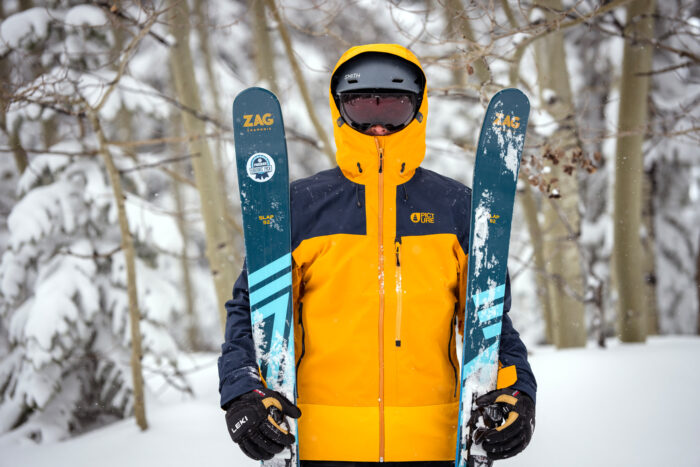
Sidecut & Turn Radius: All-Mountain Skis
The sidecut of a ski refers to the shape of the curve on either side of its length. To some degree, all skis have an hourglass shape, but the radius of these curves has a major effect on steering and stability.
Skis that are much wider at the tip and tail than at the waist will have a short turning radius. A shorter turning radius is perfect for quick and nimble movements.
When skiing tight trees or moguls, a short turning radius is a helpful feature that will help keep you in control. Anything less than 16 m can be considered a short turning radius.
Skis with a longer turning radius are generally preferred for riding fast and carving hard on wide-open groomers. While a long turning radius makes sudden nimble changes of direction difficult, it’s certainly an asset when laying down endless sweeping carves. Anything more than 20 m can be considered a long turning radius.
- 16 m or less: short turn radius, quick movement
- 16 to 20 m: moderate turn radius, many all-mountain skis
- 20 m: long turn radius, large carves
Many all-mountain skis have an all-around turning radius somewhere between 16 m and 20 m. While a ski’s sidecut does partially define its personality, it won’t tell you everything about how a ski will actually feel to use. Other factors — including profile and flex — combine with the shape of the sidecut to define the nuanced capabilities of any given ski.
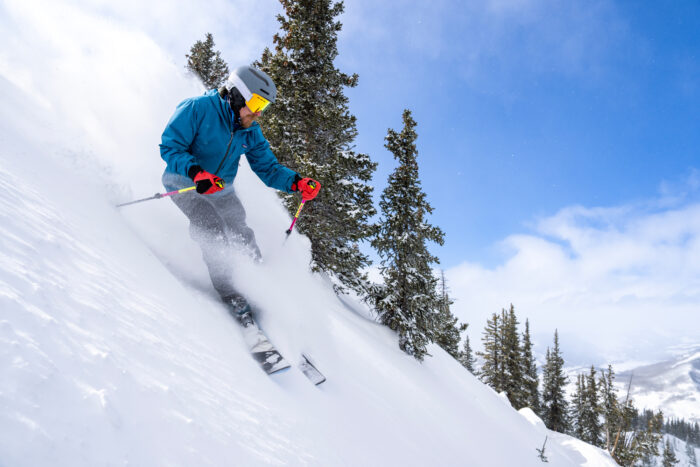
Parts of a Ski
High-quality skis are complex tools that pack lots of technology into a streamlined package. The materials and construction that make up your skis will define your experience using them.
Though there are many different ingredients involved in crafting a ski, the most important ones to be aware of are the core, laminates, sidewalls, and base.
Core and Laminates
The core of a ski is the innermost material that defines the basic structure, flex, and shape. Most all-mountain skis feature a wood core made from poplar, aspen, beech, or a combination. Foam cores are commonly found in cheaper beginner-level skis.
Around the core, layers of metal, carbon fiber, and other materials are added to boost or reduce characteristics such as pop, rigidity, and dampness.

Sidewalls
The sidewall is the material along the edge of a ski. Generally, it’s a plastic that protects the sides of the sandwiched core layers. Or, the fiberglass and top sheet layer could be extended to conceal the edge. The sidewall could also be a hybrid construction.
Base
A ski’s base is the surface that comes in direct contact with the snow. There are two kinds of bases: extruded and sintered.
Generally, extruded bases are found on beginner skis due to their low maintenance requirements. Skis with extruded bases are increasingly rare, but if you’re looking to prioritize affordability and low maintenance, they’re a reasonable option.
Sintered bases are the norm for almost all high-quality skis on the market. Though these bases require frequent waxing and general maintenance, they’re the best option for consistent all-mountain performance.

Women’s Skis vs. Men’s Skis
While some manufacturers make unisex skis, many models are specifically designed for either men or women. In the current market, men’s skis tend to have a slightly higher overall weight, increased rigidity, and a slightly setback mounting point to account for the way men tend to balance on skis.
Meanwhile, women’s skis commonly feature a mildly setback stance and are lighter and flexier. Though a women’s ski with enough rigidity for pure hard charging is harder to find, there are some excellent options available. Many women’s skis now possess all of the hard-charging power of any ski on the market.
It’s important to remember all skiers can absolutely enjoy both men’s and women’s models. Ultimately, it comes down to preference. The differences between men’s and women’s models are often subtle, and we recommend prioritizing performance and comfort over a men’s or women’s label.
If you’d like to learn about more women’s all-mountain skis on the market, check out our gear guide that highlights our favorite pairs.
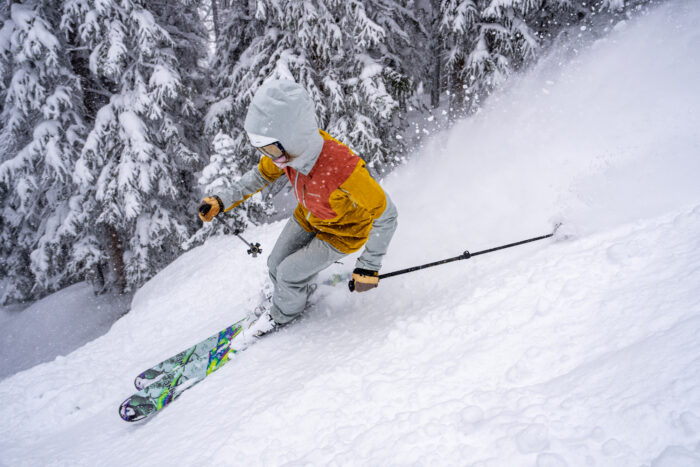
Boot & Binding Compatibility
Skis are only one part of your shredding setup, and your boots and binding are equally important components of the system. It’s crucial that all aspects of your setup work well together to provide the best performance possible.
A high-end pair of skis won’t be able to live up to its potential with low-quality boots or bindings. Generally, you want to match the strengths of your skis with boots and bindings with similar traits. For example, softer, more playful skis will work best with soft and playful boots and bindings.
Aside from this, most boots and bindings can be mounted successfully to most skis, regardless of brand. Still, we recommend checking with the manufacturer’s specs to be absolutely sure.
Sustainability
Skiing and ski resorts don’t have a great reputation for their environmental impact, but organizations such as Protect Our Winters have pushed resorts and ski brands to make sustainability a priority and, as a result, ski brands have started to introduce more sustainable materials and practices into their manufacturing.
French ski maker ZAG launched their ZAGREEN program in 2015 which aims to shorten their supply chains and swap in more sustainable materials such as bio-based raw materials such as flax and using recycled metals for edges.
Telluride’s custom ski maker Wagner has used avalanche debris and local wood sources in ski cores. Utah startup ski brand WNDR Alpine developed an algae-based oil to replace petroleum-based materials to build its skis.
Where applicable, we’ve highlighted sustainable materials and features of the skis featured in this guide.

Maintenance
Even the best skis won’t perform if you don’t keep them in good working condition. Damage to the bases can slow you down if not fixed and edges get dulled and damaged with use and should be sharpened at least a couple of times a season if you ski regularly. The right type and amount of wax applied to your bases will keep skis sliding properly.
Major repairs are generally best left to the professionals if you have access to a quality ski shop, as they require specialized materials and equipment to return the skis to like-new condition.
Minor scratches can be repaired at home with sticks of P-Tex without too much skill, but deeper incursions, especially around your edges, demand a bit more finesse and won’t last if not done properly.
Likewise, waxing can be done at home to save on professional tunes with a simple ski waxing setup. If you ski a lot, DIY waxing makes a lot of sense. Racers will wax after every ski day, but recreational skiers can get away with waxing every 5 ski days or so.
If you’re an infrequent or vacation-only skier, it may be easier to bring your skis in for a tune before a ski trip and at the end of each season. To avoid your bases drying out in the off-season, you can leave a thicker coat of wax on them through the summer and scrape it off before your first day on snow.

Mounting Bindings
Your ski shop is your best resource for choosing alpine ski bindings that are compatible with both your boots and ability level. They can also discuss the mounting point of your bindings, which can have an outsized impact on how your skis perform.
Ski manufacturers recommend a mounting point for their skis, which optimizes the ski’s edging when carving and flotation in soft snow. This is your best bet unless you know from past experience that you prefer a different mounting setup.
Most all-mountain skis are built to have more ski in front of the bindings and less length in the tails. Moving the mounting point back for a more center-mounted ski makes skis more maneuverable and may be preferred if you want to be able to turn more quickly or if you ski switch often.
There are trade-offs for any changes you make to your mount point, so make sure to discuss these pros and cons with your ski tech before committing to a mount point, as you should only mount bindings 2-3 times, and ideally, you only do it once.

Price & Value
Skis aren’t cheap. Expect to spend at least $400 on a pair of new skis, and the price usually goes up as the waist width (and thus the total amount of material) increases.
Budget All-Mountain Skis
Significant savings can be had by purchasing a pair of skis that come with bindings such as the Rossignol Experience 76 Skis + Xpress 10 GW Bindings highlighted above, but these skis will often be aimed at more beginner and intermediate skiers.
Buying used is another way to save big on sticker prices, but make sure to buy from a trusted online retailer such as evo, REI, or a good local ski shop to ensure the skis are in good condition and not a deal too good to be true.
Mid-Tier All-Mountain Skis
The majority of our favorite skis fall in this middle zone for price. Options like the Atomic Bent 110 ($700) are not made with the lightest, strongest materials but offer plenty of durability, versatility, rebound, and dampening for the average skier.
The Volkl M7 Mantra ($850) starts to creep into the premium zone with upgrades that include the 4 Radius Drive design, an advanced development of the 3D Radius Sidecut. The intent is to maximize versatility for variable snow on groomers and off-piste, increase stability on solid surfaces, and improve performance on soft snow.

Premium All-Mountain Skis
Higher-end skis from brands such as DPS can retail for more than $1,500 new. These higher-priced options usually include a higher percentage of premium materials such as carbon and may be worth the spend if your budget allows and you’re an experienced enough skier to notice the performance improvements.
One example from our guide is the Rossignol Sender 106 Open ($900), which is directional rocker built with lightweight material in the tips, sustainable wood in the core, and Titanal laminates, as well as carbon. Another option tipping the scale is the DPS Koala 111 ($900).
Frequently Asked Questions
The best all-mountain skis are the ones that suit your skill level, skiing style, and budget. On this list, we’ve included many top-quality options across a broad range of design characteristics.
Our choice for the best overall men’s all-mountain ski is the Volkl M7 Mantra.
Some all-mountain skis are excellent for beginner skiers. As a beginner, your priorities are progression and comfort. With these needs in mind, we recommend you choose a ski that is reasonably flexible and narrow. Flexible skis are easier to maneuver, and they won’t fight you for control.
Skis in the narrower range (about 70-95 mm in waist width) will be easier to shift from edge to edge. They tend to do better on the groomers where you’ll likely spend most of your time as a new skier.
On this list, we’ve selected the Rossignol Experience 76 Skis + Xpress 10 GW Bindings as the best beginner ski.
Most likely, you’ll be able to use your old boots and bindings with your new skis. Most skis will accept any bindings, though there are some exceptions. Depending on the quality of your old boots and bindings, it may be worth considering an upgrade in order to get the most out of your new skis.
Furthermore, skis can only be remounted two or three times before safety is compromised. Be sure to seek the input of a professional at your local shop if you’re unsure about the remount process.
Most all-mountain skis will perform reasonably well in the terrain park. If you’re a pure park skier, we recommend freestyle skis over all-mountain options.
However, if you enjoy wandering all over the mountain with an occasional visit to the park, all-mountain skis should do just fine. Generally, skis with better-than-average flex and pop are better than stiff and aggressive skis for park riding.
Most fatter skis up to 120 mm underfoot still have enough sidecut for carving on groomers, even if they’re primarily off-piste tools. The fatter the ski, the further your boots and bindings will be from the snow surface, so it can be harder to achieve and maintain the higher edge angles used in aggressive carving.
If you mostly value on-piste performance but still want a ski that’ll float when storms visit, look for a carving-oriented ski with camber underfoot and rockered tips and tails to help you float in soft snow.
The definition of an all-mountain ski changes with the type of skier and the manufacturer. On a personal level, a good all-mountain ski is one that you can enjoy most of the time on most of the days in the terrain you normally pursue.
For an Eastern skier that sticks mostly to groomers, that might be a 75mm waist width ski with a 16m sidecut. For a Western skier that stays off-piste, that might be a 114mm waist ski with a 25m sidecut that performs well in everything from powder to mixed chop but still skis well enough on the groomers back to the base.
More important than analyzing whether or not a particular ski is considered “all-mountain,” is finding a ski that matches your abilities, preferred terrain, and the conditions you normally encounter.
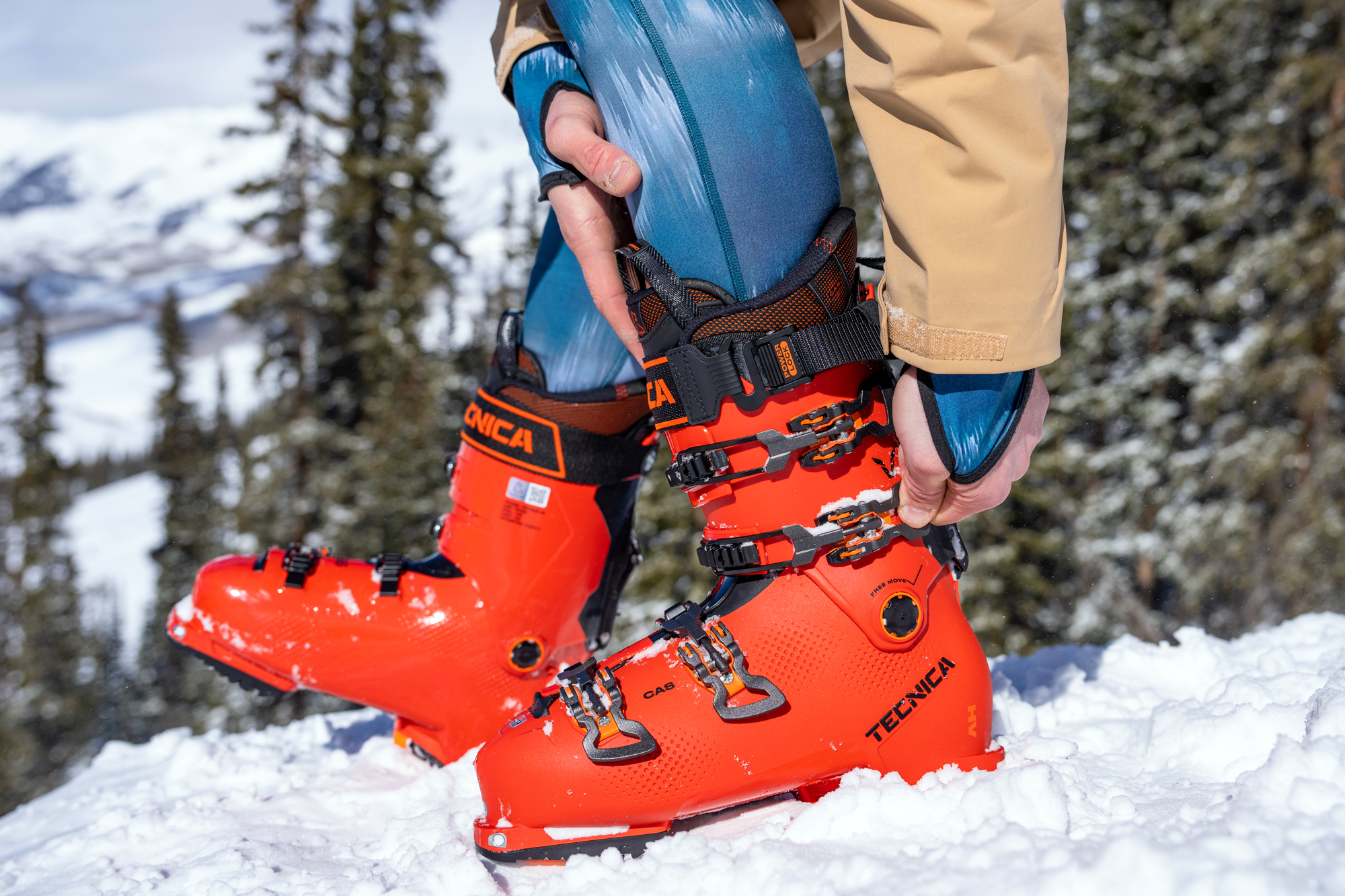
The Best Ski Boots of 2025-2026
Our experts tested the best ski boots including downhill, hybrid, and backcountry pairs from Tecnica, Salomon, Nordica, and more.
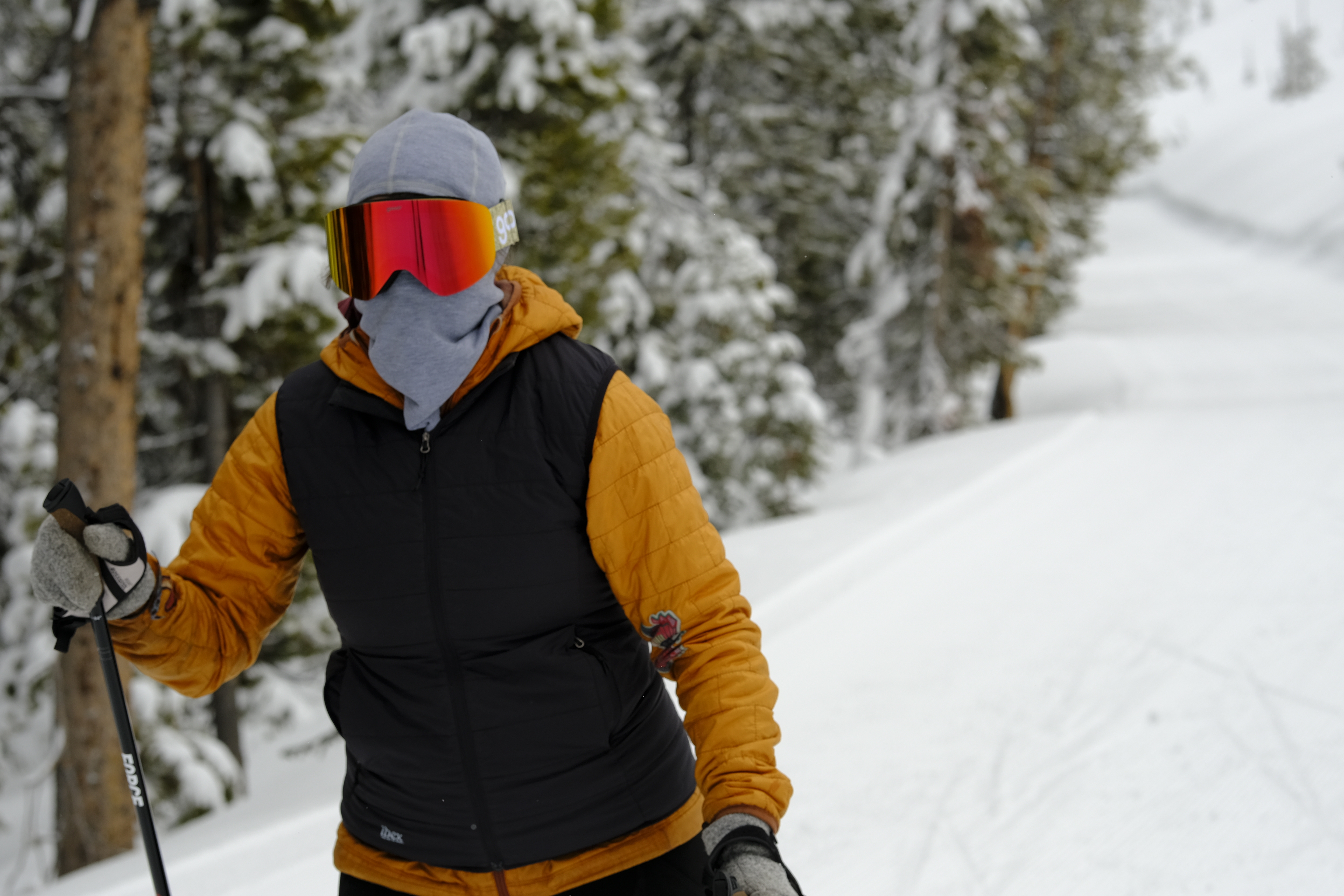
The Best Face Coverings for Skiing & Snowboarding of 2025-2026
We tested the best face coverings for skiing and snowboarding from Turtle Fur, Buff, REI, Smartwool, and more to help you find the best option for your needs and budget.

